


ANTIGEN MISSES 1 IN 3 CASES.
Cepheid delivers high-performing test results, with up to 99% PPA for Xpert® Xpress CoV-2 plus^ — eliminating the uncertainty.
your standard







Cepheid delivers high-performing test results, with up to 99% PPA for Xpert® Xpress CoV-2 plus^ — eliminating the uncertainty.
your standard





Real-time consultation for your patients that can’t wait. CellaVision® connects your experts with the samples that can’t wait. Instead of mailing slides through your system, easily email cell images from the CellaVision software, or use Remote Review and Database Server to enable real-time collaboration throughout your entire network. For your patients, the wait is over. Visit Sysmex.com/CellaVision

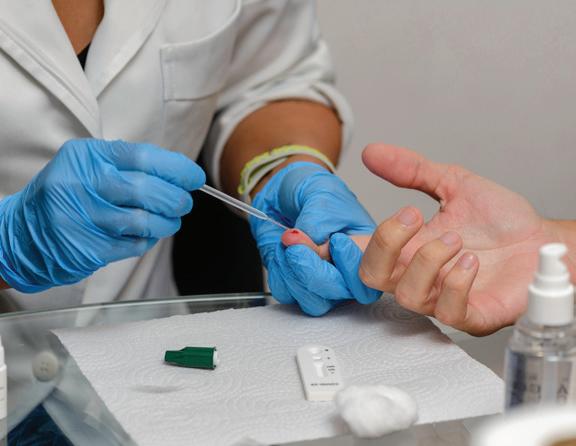

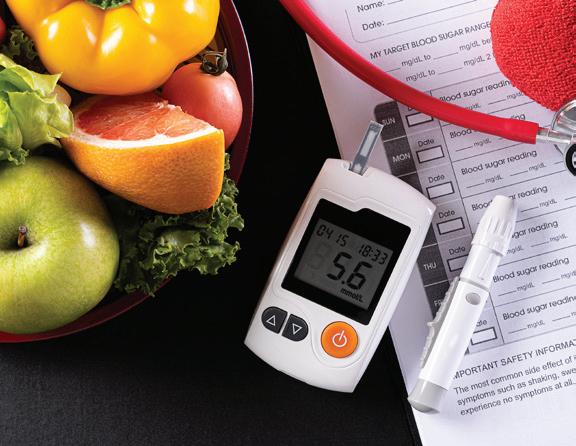

By Jaime A. Nieto Sierra, DBA, MHA and Apoorv Kumar
Colleen Strain, PhD
Maria Paulina Posada-Vergara,



If a hospital performs one million tests per year and loses one in 1,400 tubes at a cost of $400–600 per tube, then the annual cost could be as much as $428K—not to mention the burden on patients and hospital.1
By implementing Indexor, you can trace samples starting at patient draw, monitor key quality indicators during transportation, and automate time-consuming lab operations.
Vol. 57, No. 6

By Christina Wichmann
Editor in Chief
On June 18, 2025, CMS published an update to its practices on the release of CMS-2567 in QSO-25-19-All. This form will now be publicly released within 14 days after receipt by the provider, supplier, or lab — this change effectively allows immediate release. Labs generally have ten days to develop and submit a response to the findings, which may include a Plan of Correction (POC) and/or Allegation of Compliance (AOC). This is not changing.
Previous practice by CMS held the public release of CMS-2567 for up to 90 days after the completion of a survey or until a POC or AOC had been approved by CMS. CMS-2567 is the record of the survey where the surveyor(s) documents and justifies the determination of compliance for CLIA certification. The information/survey findings serve as the basis for the laboratory to analyze its deficient practices or system failures and to develop plans of correction. CMS-2567 may also document deficient practices identified by means other than an on-site survey (e.g., an off-site review of unsuccessful proficiency testing scores).
On June 23, 2025, CMS published circumstances that it will be exercising enforcement discretion (authority of regulatory agencies to determine how and when to enforce regulations) regarding new personnel regulations that went into effect December 28, 2024. The following is communicated in QSO-25-21-CLIA:
• CMS will be exercising enforcement discretion in the following limited circumstances with respect to certain regulatory personnel qualification requirements and plans to address these changes in future notice-andcomment rulemaking: CMS will allow laboratory directors qualifying under 42 CFR 493.1405(b)(2) to have either at least one year of experience directing or supervising nonwaived laboratory testing or 20 continuing education (CE) credit hours in laboratory director responsibilities.
• CMS will not require the additional 20 CE credit hours currently required under §493.1405(b)(3)(ii), 493.1405(b)(4)(iv), 493.1405(b)(5)(iv), 493.1443(b)(2) (iii), and 493.1443(b)(3)(iv). As such, any individual previously qualified as a clinical consultant will be able to continue to qualify without taking an additional 20 CE credits.
• CMS will allow for individuals qualified as technical supervisors under §493.1449(f)(2)(i) to qualify as high-complexity laboratory directors for testing in dermatopathology.
• In addition, CMS is clarifying the following and plans to address in future notice-and-comment rulemaking:
• “An approved thesis or research project related to laboratory testing for the diagnosis, prevention, or treatment of any disease or impairment of, or the assessment of the health of, human beings,” as required under §493.1405(b) (3)(i)(B)(2), 493.1405(b)(4)(i)(C)(2), 493.1443(b)(3)(i)(B)(2), and 493.1449(c)(4)(i) (C)(2) does not need to be on human subjects, as most research is performed on animal models.
• The requirements under §493.1443(b)(3)(iii) for high-complexity laboratory directors to require a total of two, not four, years of laboratory training or experience and laboratory experience directing or supervising high complexity testing.
These and other CMS memos can be viewed at https://www.cms.gov/medicare/health-safety-standards/quality-safety-oversight-general-information/ policy-memos/policy-memos-states-and-cms-locations.
I welcome your comments and questions — please send them to me at cwichmann@mlo-online.com.
PUBLISHER Chris Driscoll cdriscoll@endeavorb2b.com
EDITOR IN CHIEF Christina Wichmann cwichmann@mlo-online.com
MANAGING EDITOR Erin Brady ebrady@endeavorb2b.com
PRODUCTION MANAGER Edward Bartlett
ART DIRECTOR Kelli Mylchreest
AUDIENCE DEVELOPMENT/LIST RENTALS Laura Moulton | lmoulton@endeavorb2b.com
ADVERTISING SERVICES MANAGER Karen Runion | krunion@endeavorb2b.com
ADVERTISING
DIRECTOR OF SALES
EAST COAST/MIDWEST SALES, CLASSIFIEDS Carol Vovcsko (941) 321-2873 | cvovcsko@mlo-online.com
SOUTH/WEST COAST/ILLINOIS SALES Lora Harrell (941) 328-3707 | lharrell@mlo-online.com
MLO EDITORIAL ADVISORY BOARD
John Brunstein, PhD, Biochemistry (Molecular Virology) President & CSO PathoID, Inc., British Columbia, Canada
Lisa-Jean Clifford, COO & Chief Strategy Officer Gestalt, Spokane, WA
Barbara Strain, MA, SM(ASCP), CVAHP Principal, Barbara Strain Consulting LLC, Formerly Director, Value Management, University of Virginia Health System, Charlottesville, VA
Jeffrey D. Klausner, MD, MPH Professor of Preventive Medicine in the Division of Disease Prevention, Policy and Global Health, Department of Preventive Medicine at University of Southern California Keck School of Medicine. Donna Beasley, DLM(ASCP), Director, Huron Healthcare, Chicago, IL
Anthony Kurec, MS, H(ASCP)DLM, Clinical Associate Professor, Emeritus SUNY Upstate Medical University, Syracuse, NY
Suzanne Butch, MLS(ASCP)CM, SBBCM, DLMCM Freelance Consultant, Avon, OH
Paul R. Eden, Jr., MT(ASCP), PhD, Lt. Col., USAF (ret.), (formerly) Chief, Laboratory Services, 88th Diagnostics/Therapeutics Squadron, Wright-Patterson AFB, OH
Daniel J. Scungio, MT (ASCP), SLS, CQA (ASQ), Consultant at Dan the Lab Safety Man and Safety Officer at Sentara Healthcare, Norfolk, VA CORPORATE TEAM
CEO Chris Ferrell
COO Patrick Rains
CRO Paul Andrews CDO Jacquie Niemiec CALO Tracy Kane CMO Amanda Landsaw EVP HEALTHCARE, CITY SERVICES & DIGITAL INFRASTRUCTURE Kylie Hirko 30 Burton Hills Blvd., Suite 185 Nashville, TN 37215 800-547-7377 | www.mlo-online.com
Medical Laboratory Observer USPS Permit 60930, ISSN 0580-7247 print, ISSN 2771-6759 online is published 10 times annually (Jan, Mar, Apr, May, Jul, Aug, Aug-CLR, Sep, Oct, Nov) by Endeavor Business Media, LLC. 201 N Main St 5th Floor, Fort Atkinson, WI 53538. Periodicals postage paid at Fort Atkinson, WI, and additional mailing offices. POSTMASTER: Send address changes to Medical Laboratory Observer, PO Box 3257, Northbrook, IL 60065-3257. SUBSCRIPTIONS: Publisher reserves the right to reject non-qualified subscriptions. Subscription prices: U.S. $160.00 per year; Canada/Mexico $193.75 per year; All other countries $276.25 per year. All subscriptions are payable in U.S. funds. Send subscription inquiries to Medical Laboratory Observer, PO Box 3257, Northbrook, IL 60065-3257. Customer service can be reached toll-free at 877-382-9187 or at MLO@ omeda.com for magazine subscription assistance or questions. Printed in the USA. Copyright 2025 Endeavor Business Media, LLC. All rights reserved. No part of this publication may be reproduced or transmitted in any form or by any

The smarter diagnostic solution for bloodstream infections

results to guide life-saving treatment decisions in the fight against sepsis and antimicrobial resistance1
The LIAISON PLEX® Bloodstream Infection Portfolio features three FDA-cleared multiplex molecular assays, offering comprehensive pathogen detection for 48 bacterial and fungal species associated with bloodstream infections and sepsis, and 12 clinically significant antimicrobial resistance markers, enabling rapid, targeted antimicrobial interventions to optimize patient care.
Designed for seamless laboratory workflow integration, the system minimizes unnecessary testing and enhances diagnostic accuracy. By supporting evidence-based decision-making, it advances antimicrobial stewardship initiatives and optimizes patient management outcomes.
1. Taryn A Eubank, et all , Role of Rapid Diagnostics in Diagnosis and Management of Patients With Sepsis, The Journal of Infectious Diseases, Volume 222, Issue Supplement_2, 15 August 2020, Pages S103–S109.

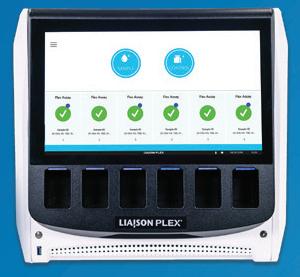




LIAISON PLEX® BSI
Optimize treatment in hours – not days.
LIAISON PLEX® Gram-Positive Blood Culture Assay
LIAISON PLEX® Gram-Negative Blood Culture Assay
LIAISON PLEX® Yeast Blood Culture Assay

















































































By Jaime A. Nieto Sierra, DBA, MHA and Apoorv Kumar
Hospitals across the United States are facing significant financial pressures, with operating margins experiencing fluctuations in recent years. Combined operating margins decreased from 8.9% in 2021 to 2.7% in 2022 before increasing to 5.2% in 2023. However, both combined operating margins and total margins have
remained below 2019 pre-pandemic levels in 2023.1
There are several factors that have contributed to these financial difficulties, including:
1. Lower reimbursement rates: Hospitals have experienced reduced payments from government payers (Medicare/Medicaid) and com-
See test online at https://ce.mlo-online.com/courses/test-smarter-not-harder-boostingquality-and-reducing-avoidable-costs-through-laboratory-stewardship/
Passing scores of 70 percent or higher are eligible for 1 contact hour of P.A.C.E. credit.
LEarning oBJECtiVEs
Upon completion of this article, the reader will be able to:
1. Define laboratory diagnostic stewardship.
2. Describe outcomes of an organization’s stewardship program.
3. Identify actionable test utilization practices. Scan code to go directly to the CE test.
mercial insurers, impacting overall revenue streams.
2. Rising labor expenses: Labor costs, which generally account for about half of a hospital’s total expenses, have risen significantly, driven in part by increased dependence on contract labor agencies.2
3. Higher costs for medical supplies and diagnostic equipment: Hospitals have faced increased operational costs due to rising expenses related to prescription drugs and supplies.3
4. Shifts in patient care from inpatient to outpatient settings: The transition to outpatient care has led to reduced inpatient volumes, affecting top line revenues for hospitals.
5. Increased regulatory compliance costs: Hospitals must invest in compliance measures to meet regulatory requirements, adding to operational costs.
Considering these financial constraints, hospital leadership must
find innovative ways to reduce operating expenses while sustaining and/ or increasing the quality of care that is being offered. One opportunity for cost savings lies in optimizing laboratory test utilization through stewardship programs.
Laboratory and pathology diagnostic stewardship refers to the coordinated effort to ensure that diagnostic tests are used appropriately and effectively to reduce unnecessary testing, reduce costs, and maintain or improve patient outcomes. Advancements in laboratory medicine have increased the availability of complex and specialized tests, and overuse of laboratory tests has been a growing problem in hospital settings, contributing to rising healthcare costs. Factors such as clinical routines, lack of cost transparency, and the convenience of electronic health record (EHR)-based ordering play significant roles in this overutilization.4 By integrating best practices and evidence-based guidelines, laboratory stewardship programs (LSPs) assist hospital systems in managing diagnostic utilization effectively amid tightening financial margins, rising operational costs, and regulatory compliance challenges.
Kaiser Permanente is one of the largest integrated healthcare systems in the United States, serving over 12 million patients across eight states and a federal district. With over 35 hospitals and over 600 medical offices, it is known for its innovative care models, such as the early adoption of EHRs and value-based care initiatives. The organization is also committed to sustainability, implementing various environmental and healthcare stewardship programs to improve efficiency and patient outcomes.
The organization recognizes the importance of LSPs as a critical strategy for improving healthcare efficiency and reducing unnecessary diagnostic testing. To formalize these efforts, it established the Laboratory & Pathology (L&P) Utilization Committee, which serves as an advisory body dedicated to defining best practices in ordering laboratory diagnostics. The committee’s primary objectives include reviewing test utilization, establishing appropriateness criteria, minimizing variations in diagnostic testing, and reducing external testing costs through evidence-based decision-making.
Stemming from the LSP initiative, Kaiser launched the “Test Smarter, Not Harder” initiative (the Initiative), which focuses on improving laboratory efficiency within its Greater Southern
Kaiser Permanente recognizes the importance of laboratory stewardship programs as a critical strategy for improving healthcare efficiency and reducing unnecessary diagnostic testing.
Alameda Area (GSAA) network. The Initiative has three broad focuses: first, those tests currently being conducted externally that could feasibly be performed within the internal laboratory network; second, tests already being processed internally but which might be achievable at a significantly lower cost through alternative test choice; and third, tests —conducted internally or externally — that may be clinically unnecessary and could be safely avoided all together.
This article summarizes the first focus of the Initiative: leveraging a data-driven approach to identify tests being conducted externally that can be internalized. A key component of the project is to centralize laboratory utilization data that is currently fragmented across multiple laboratory units within the GSAA network and develop an organizational framework for conducting these evaluations regularly.
This project followed a structured, multi-step approach grounded in data analysis and stakeholder engagement. The initial step involved developing a thorough understanding of the modalities of laboratory test collection and processing across the GSAA network, which include four primary laboratory and pathology centers located in Sleepy Hollow, Union City, Fremont, and San Leandro. We worked with the regional laboratory operations team to collect and collate laboratory test utilization data across all four sites for the 2024 calendar year. Once the data sets were consolidated, we conducted a detailed review to understand how the data had been stratified and whether tests
outsourced to external laboratories could be reliably identified.
We then analyzed the dataset to identify the top 10 tests that were most frequently sent outside the network. These tests would be selected as priority targets for potential internalization. With this data in hand, we would then collaborate with the finance team to assess the direct costs associated with outsourcing these tests, providing insights into the financial burden they place on the system.
With this foundational analysis in place, we conducted stakeholder interviews across the laboratory, operations, and finance departments to understand the workflow implications of internalizing these tests. This pro forma assessment aimed to estimate the potential cost savings associated with internalizing the selected tests. Finally, based on the findings from the data analysis and stakeholder consultations, the project would culminate in the development of a scalable recommendations that would enable the health system to replicate this LSP on an annual basis, ensuring ongoing optimization of diagnostic services across the GSAA network.
When we first looked at the laboratory utilization data from 2024, we observed that the GSAA network had made over four million test orders. Of these tests, we were able to extract that ~41.4% of these tests were classified as “send-in,” and 58.6% of them were “send-out” tests. Additional data allowed us to stratify the “send out” data into segments which reflected the location where the tests were processed: in-network regional
Location Grand Total other 59,487 other in-network labs 3,703 in-network regional labs 2,357,437 total 2,420,627
Table 1. initial laboratory utilization stratified dataset.
labs, other in-network labs, and other. From this stratified data, the set that we were most concerned with were the tests classified as “Other,” as these were the tests that were sent to labs outside the health system network.
We determined that only ~2.46% of these tests that were classified as “send out” were actually tests that were sent to reference labs outside the network.
Table 1 highlights the breakdown of the number of tests and their respective stratification.
With this data in hand, we wanted to get a broad picture of the financial implications of having just shy of 60,000 tests being sent out of the network. In our conversations with the finance team, we were able to determine that a total of $16.5 million was spent across the year on testing by the GSAA unit, of which ~$5.8 million were attributable to tests sent out of the network.
Our analysis unearthed the top ten tests that were being sent out of the network from the GSAA unit. These are listed in Table 2.
such as well-child visits, prenatal care, or standard admissions. These order sets are typically pre-configured by clinical teams and are designed to reduce cognitive burden and improve order processing times by allowing providers to select a comprehensive panel of recommended tests with minimal manual input.
3. Data fragmentation and manual processes: Stakeholders from both laboratory operations and information system s teams highlighted significant challenges in data extraction and consistency. The process of identifying the misclassification of the “miscellaneous reference labs” tests not being captured in a standardized way across the GSAA network reflects this (See Limitations section below). This has led to a reliance on tedious data cleaning and reconciliation, increasing the risk of errors in data analysis.
4. Clinical department–specific ordering patterns and legacy practices:
Clinical departments exhibit distinct ordering behaviors:
• Pediatrics: Orders a high volume of tests, often to avoid repeat visits for children, which drives up external test utilization numbers for the department. The care model prioritizes minimizing patient inconvenience, sometimes at the expense of test stewardship.
• OB/GYN: Most tests ordered are already conducted internally, apart from state-mandated genetic screenings. For which, genetic counselors or maternal-fetal medicine specialists typically handle external orders, which fall under the “miscellaneous reference lab” test category. In this department there is a formal steering committee overseeing prenatal genetic test orders, and some tests are charged to the genetics team rather than to the L&P team budget.
With this information, we see that these tests account for just shy of 50% of the tests being sent out of the network, and the data collected from the finance team reflected that total expenditure for conducting all these tests was $1.58 million.
The structured interview with clinicians, laboratory staff, and administrative stakeholders across the GSAA network revealed several recurring themes and nuanced insights regarding laboratory test ordering, data flow, and stewardship practices. The following synthesis highlights the most prominent findings:
1. Limited physician awareness of test routing:
A consistent theme was the lack of awareness among physicians regarding where laboratory tests are ultimately processed. Multiple clinicians emphasized that, aside from a few exceptions (notably “miscellaneous reference tests”), they generally do not know whether a test order is fulfilled internally, by a regional lab, an innetwork lab, or to an external reference laboratory. Test routing is largely determined by pre-set options within the EHR system.
2. Reliance on “smart set” test ordering:
The interviews revealed a common trend of widespread reliance on standardized order sets or “smart sets” within the EHR system. Physicians across specialties routinely use these smart sets to streamline the ordering process for common clinical scenarios,
• Gastroenterology: Relies on long-standing legacy ordering processes. Certain tests (e.g., Prometheus panels) are ordered out of habit, and there is little awareness or incentive to change these patterns. Over-ordering of specific tests like calprotectin or H. Pylori was noted, with suggestions that more critical evaluation of the clinical necessity of ordering these tests is warranted.
5. Existing stewardship mechanisms:
Some departments have implemented stewardship strategies, particularly within the OB/GYN and highrisk pregnancy care. These include:
• A combination in the use of smart sets along with a decision support tool in the EHR, designed to streamline ordering and reducing unnecessary tests.
• Hard stops and prompts for certain tests to ensure appropriateness.
• Oversight by genetics teams and steering committees for high-cost or high-volume genetics tests. Overall, from these insights we can say that the workflow for laboratory test ordering is characterized by a high degree of automation, limited clinician visibility into test routing, and clinical departmental-specific adaptations. The interviews highlight both the efficiency and the opacity of the current system, suggesting that greater transparency and ongoing review of ordering protocols could further optimize test utilization and support laboratory stewardship goals.
Finally, the stakeholder interviews also provided valuable, practical recommendations on which laboratory tests could be prioritized for internalization within the GSAA
• Liquid, ready-to-use
• Superior stability
• Fast, reliable results

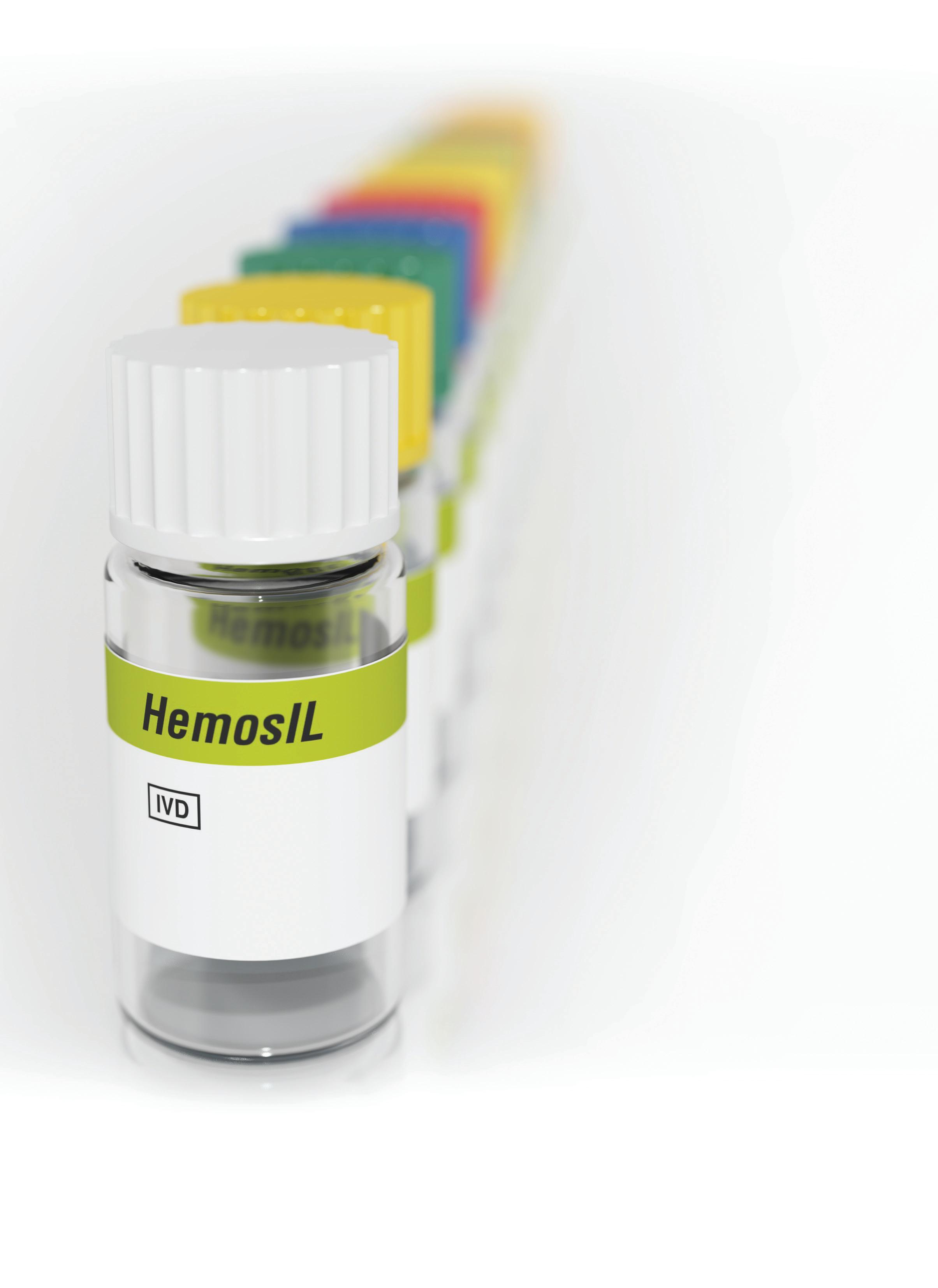

Enhance efficiency with our robust liquid, ready-to-use reagents. Central to Werfen’s total Hemostasis testing solution, our comprehensive line of HemosIL reagents deliver superior onboard stability and fewer manual steps—from routine to specialty testing. Other key components include ACL TOP® Family 50 Series systems with automated pre-analytical sample integrity checks, and HemoCell Specialized Lab Automation, designed specifically for the automation of Hemostasis testing. Rely on HemosIL reagents for improved laboratory efficiency—for better patient care.
Simply efficient.
For more information, contact your local Werfen representative. werfen.com
network. Clinicians and administrative staff consistently identified several high-volume or frequently ordered tests that, if brought in-house, could yield significant cost savings and operational efficiencies.
Discussion and recommendations
The findings from this project reveal significant and actionable insights into laboratory tests utilization and stewardship within the GSAA network. The data and stakeholder interviews collectively highlight the dual challenge of optimizing test ordering practices while navigating substantial data and workflow barriers. These challenges are not merely operational inconveniences; they have direct implications for cost efficiency, clinical quality, and the ability to implement sustainable LSPs.
Based on the findings, several recommendations have emerged:
1. Standardization and integration of data systems:
We recommend that the GSAA network develop systemwide definitions and automated categorization for send-out tests, including “miscellaneous reference lab” tests. This will reduce the administrative burden for reconciliation of volumes, improve cost tracking, and enable more accurate stewardship analysis.
2. Improve clinician cost transparency and decision support systems: Modify EHR interfaces to provide real-time feedback on test routing and costs at the point of order entry. Incorporate decision support systems or “hard stops” for high-cost or high-volume tests, as already piloted in the OB/GYN department, to encourage evidence-based ordering and reduce unnecessary externalization of tests.
3. Prioritize internalization of highvolume ordered tests with predictable order patterns: Focus on internalizing those tests with predictable, high demand - such as cystic fibrosis carrier screening, H. Pylori, and calprotectin. This approach should be supported by clinical consensus.
4. Establish a GSAA multidisciplinary stewardship committee: Create a standing committee with annually rotating representation from clinical, laboratory, information technology, and finance departments to oversee test utilization patterns and monitor impact of stewardship

interventions. Regular review (e.g., annual) and feedback cycles are critical for sustaining improvements.
5. Establish clinical department level stewardship committees:
To complement the multidisciplinary stewardship committee, establish a structured process for annual review of EHR smart sets by departmental stewardship committees. This approach builds on existing efforts while addressing gaps identified in specialties. In addition, departmental stewardship committees will provide sub-departmental context to test ordering patterns to ensure there is a weighted criteria-based recommendation when required.
6. Ongoing education and communication:
Finally, the GSAA network should implement educational initiatives to inform clinicians about internal testing capabilities and impact of their ordering practices. Foster a culture of stewardship through regular updates and transparent reporting of utilization data.
This project faced several limitations. First, the reliability of quantitative analysis was constrained by inconsistent data entry and hard coding, particularly for “miscellaneous reference lab” tests. We discovered that a portion of these tests were technically sent outside the health system network but were not captured in the official “send-out” section of the
data. These tests, totaling approximately 2,298, were labeled as miscellaneous and stored in the “send-in” section of the data. The need for extensive data cleaning introduced a risk of error in data integrity. In addition, the lack of analysis of this data highlights the possible limitations in the recommendations offered.
Second, the interview sample, while diverse, may not be a complete representation of perspectives of all clinical departments. This means that there needs to be a more representative sample before the insights can be generalized.
Third, the analysis focused primarily on cost and volume outcomes, without direct measurement of clinical impacts such as turnaround times or patient outcomes. Finally, the findings are specific to the GSAA network and may not be fully generalizable to other regions or the entire health system with different organizational structures or EHR configurations.
Scan code to go directly to the CE test.
In summary, this project demonstrated that meaningful LSPs require more than identifying high-cost tests; it demands investment in data infrastructure, workflow transparency, and interdisciplinary collaboration. These findings echo national trends where stewardship success is often linked to targeted, departmental-driven interventions and strong governance structures. Addressing the highlighted challenges will not only foster a culture of continuous quality improvement, but it could also result
in financial savings and care quality excellence. By implementing the recommended strategies, the GSAA network can position itself as a leader in LSPs and set a replicable standard for the rest of the health system and other integrated healthcare systems in the country.
We would like to acknowledge and thank the laboratory staff and leadership team for their work and guidance during the review process, in particular Stacey Aggabao MBA, MSN RN NEA-BC CEN CTACC; Elena Soriano CLS, MLS (ASCP); Susan Tannenbaum CLS (ASCP); and Kathy M. Taylor.
1. Levinson Z, Godwin J, Neuman T. Hospital margins rebounded in 2023, but rural hospitals and those with high Medicaid shares were struggling more than others. KFF. Published December 18, 2024. Accessed June 24, 2025. https://www.kff.org/health-costs/ issue-brief/hospital-margins-rebounded-in2023-but-rural-hospitals-and-thosewith-high-medicaid-shares-were-strugglingmore-than-others/.
2. Krishnamurthy B. Margin misconceptions: What do break-even hospital margins mean for patient care? American Hospital Association | AHA News. Published August 1, 2023. Accessed June 24, 2025. https://
www.aha.org/news/blog/2023-08-01-marginmisconceptions-what-do-break-evenhospital-margins-mean-patient-care.
3. Costs of caring. American Hospital Association. Published April 2025. Accessed June 24, 2025. https://www.aha.org/costsofcaring.
4. Shaik T, Mahmood R, Kanagala SG, et al. Lab testing overload: a comprehensive analysis of overutilization in hospital-based settings. Proc (Bayl Univ Med Cent) 2024;37(2):312-316. doi:10.1080/08998280.2 023.2288788.

Jaime A. N ieto Sierra, DBA, MHA is a retired u s a ir Force veteran and a published, award-winning, social sciences researcher with a rich array of skills and over 17 years of leadership experience in healthcare and life sciences administration. he currently serves as the director of operations for a mbulatory s ervices and pathology general at Kaiser Permanente’s Greater Souther n Alameda Area.
prior to joining Kaiser, Jaime served in the u s a ir Force, where he held leadership positions in various healthcare settings, including academic institutions, clinical lab and investigation facilities, and hospitals of varying sizes, including mid-sized and large facilities. his areas of expertise include business strategy, project management, organizational behavior, organizational learning, and regulatory compliance.


INFO@SURE -TECH.NET
WWW.SURE -TECH.NET
*Also Distributed through Fisher Scientific

A poorv Kumar began his career in the heart of preventative medicine— vaccines—working with Bharat Biotech, one of india’s largest vaccine manufacturers. in this role, he led the commercialization of critical vaccines, including efforts to expand access to the company’s C o V id -19 vaccine across global markets. his work included building out supply chains and forging long-term partnerships across Latin a merica, where he negotiated major contracts with multilateral agencies.
t hese experiences, though deeply impactful, revealed the immense pressure that infectious diseases place on an already strained health system. t his realization spurred a poorv to explore the healthcare provider segment and its operational challenges more closely. t hrough consulting engagements with Marin health and an internship with Kaiser permanente, he immersed himself in the strategic and financial decision-making processes of health systems. Currently pursuing a dual MB a /M ph at the u niversity of California, Berkeley, a poorv brings a unique lens that bridges biopharma innovation, public health, and hospital operations. he is passionate about ensuring that high-quality healthcare can be delivered as efficiently as possible to as many people as possible.
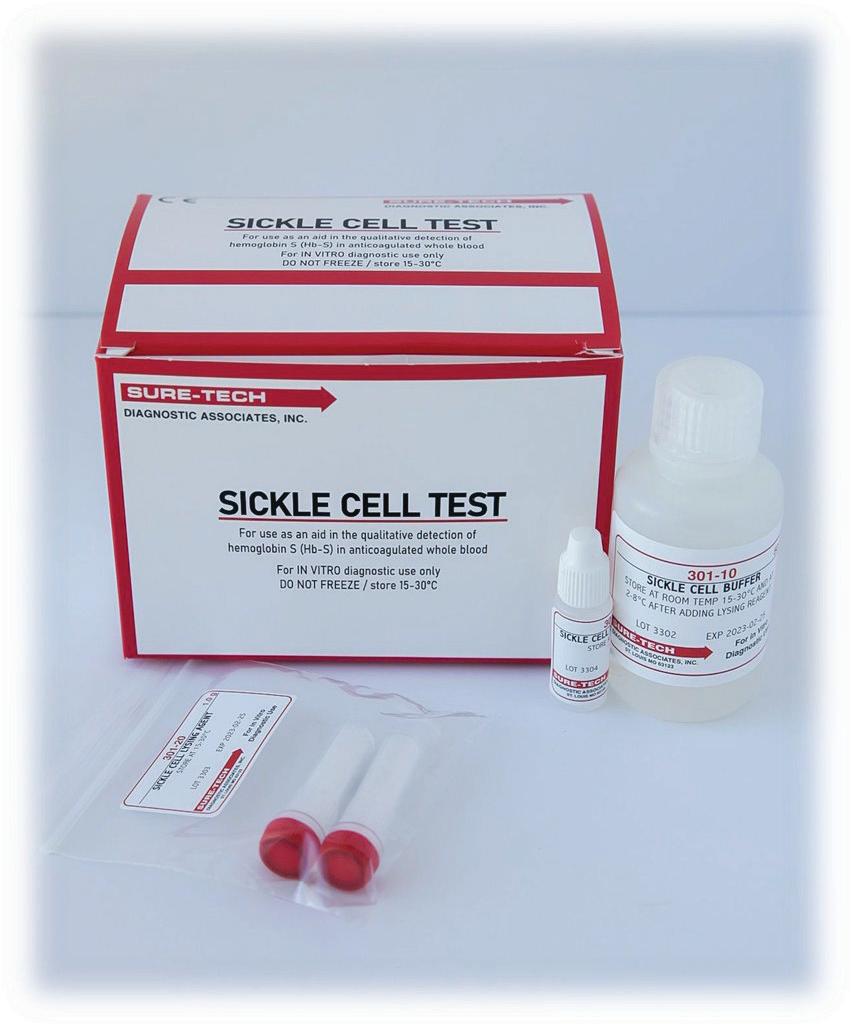
By Colleen Strain, PhD
The UNIVANTS of Healthcare Excellence program is a prestigious global award program that recognizes integrated clinical care teams who have strategically mobilized insights from laboratory medicine to enable greater outcomes and improved patient care.1,2 In 2025, the UNIVANTS program proudly recognized impressive work from nine integrated clinical care teams who have not only unified across the care continuum, but achieved measurably better outcomes for patients, clinicians, health systems/ administrations, and payors.
All nine of the recently recognized best practices have made measurable improvements to care, including improving wellness, reducing lengths of stay, protecting patient safety, improving patient flow, and more. With three top global winners, three teams of distinction, and three teams of achievement, these innovative initiatives are fueled by laboratory medicine to make a difference. For details on all winners, please visit www.UnivantsHCE.com.
The 2025 top global winners of this prestigious healthcare excellence award include Centre Hospitalier Universitaire of Clermont-Ferrand, Musashino Red Cross Hospital, Complejo Hospitalario Universitario Nuestra Señora de Candelaria.
TBI strategies: Expediting patient flow and reducing length of stay through blood biomarker–guided management of patients with suspected mild traumatic brain injury
An integrated clinical care team from Clermont-Ferrand, France, recognized that patients who present to the emergency department (ED) with a traumatic brain injury (TBI) often require a CT scan, which is typically conducted between 4-8 hours after the injury. For patients with mild TBI (mTBI), the incidence of complications is low and thus CT scans are often negative. Consequently, patients can spend substantial

time waiting for imaging, compounding ED overcrowding, while being exposed to potentially unnecessary radiation from the CT scan.
With a strong understanding of existing evidence, this integrated clinical care team sought to improve patient flow in the (ED), while reducing length of stay through implementation of a brain biomarker– guided decision pathway to reduce unnecessary CT scans. Their collaborative effort reduced length of stay for mTBI patients by over 3 hours, thus mitigating 2,300 resource hours each year from medical and non-medical staff as a direct result of expedited patient flow.
The pathway to HCV elimination: Multidisciplinary team effort for improved identification, diagnosis, and treatment of
Early identification of hepatitis C is a globally relevant and important goal, with the World Health Organization (WHO) global hepatitis strategy aiming to achieve a 90% reduction in
new infections and 65% reduction in deaths by 2030.3 In Japan, an estimated 1.0–1.5 million people have undiagnosed and/or untreated hepatitis C (HCV) infections. 4 The Musashino Red Cross Hospital is a regional core center for liver disease treatment in Tokyo, with initiatives that actively promote and work toward hepatitis elimination, including enhanced recommendations for screening, follow-up, and consultation for patients who test positive for HCV antibodies, in addition to e-alert systems to further encourage clinical action.
Recognizing that identification of patients with untreated HCV requires
For more information on UNIVANTS, the 2025 winners, and/or to apply starting August 1st, please visit www.UnivantsHCE.com.
multi-faceted initiatives, the Musashino Red Cross Hospital built upon their previous best practices to implement new processes for follow-up that link patients to care and treatment.
This multi-disciplinary initiative involved laboratory medicine, doctors, nurses, and administrative staff and has reduced the unreferred rate for patients with HCV antibody positivity by 33.7% [from 34.8% (2020) to 1.1% (2024)] and led to an 8.3% reduction [from 10.2% (2022) to 1.9% (2024)] in the number of known HCV positive patients without treatment. Impressively, clinicians in other departments have also changed their behavior thanks to comprehensive educational efforts, enabling a 6.2% increase [from 17.5% (2022) to 23.7% (2023)] in clinical adherence to hospital recommendations for medical history checks, relevant HCV antibody testing and subsequent referrals, as appropriate. Collectively, these efforts are mitigating preventable liver cancers, with mitigated costs of approximately 46.4 million yen/year.
Radiation reduction: Increased safety and improved length of stay for patients with suspected mild traumatic brain injury in the emergency department
The importance of TBI management is evident, with a second team receiving top recognition in 2025 for their brain biomarker–guided decision pathway. The integrated clinical care team from Santa Cruz de Tenerife, Spain, recognized that most of their patients with mTBIs spend an average of 8.7 hours in

the ED waiting, and they are often discharged without the need for significant intervention. With the goal of reducing unnecessary radiation and improving length of stay, this integrated clinical care team incorporated glial fibrillary acidic protein (GFAP) and ubiquitin carboxyterminal hydrolase L1 (UCHL-1), into their decision-making pathway to help rule-out the need for CT scans for patients with suspected mTBI.
Since implementation in 2022, this integrated clinical care team has evaluated over 5,000 patients in the ED for mTBI, with an impressive 36% of mTBI patients safely avoiding unnecessary CT scans. This has further enabled a
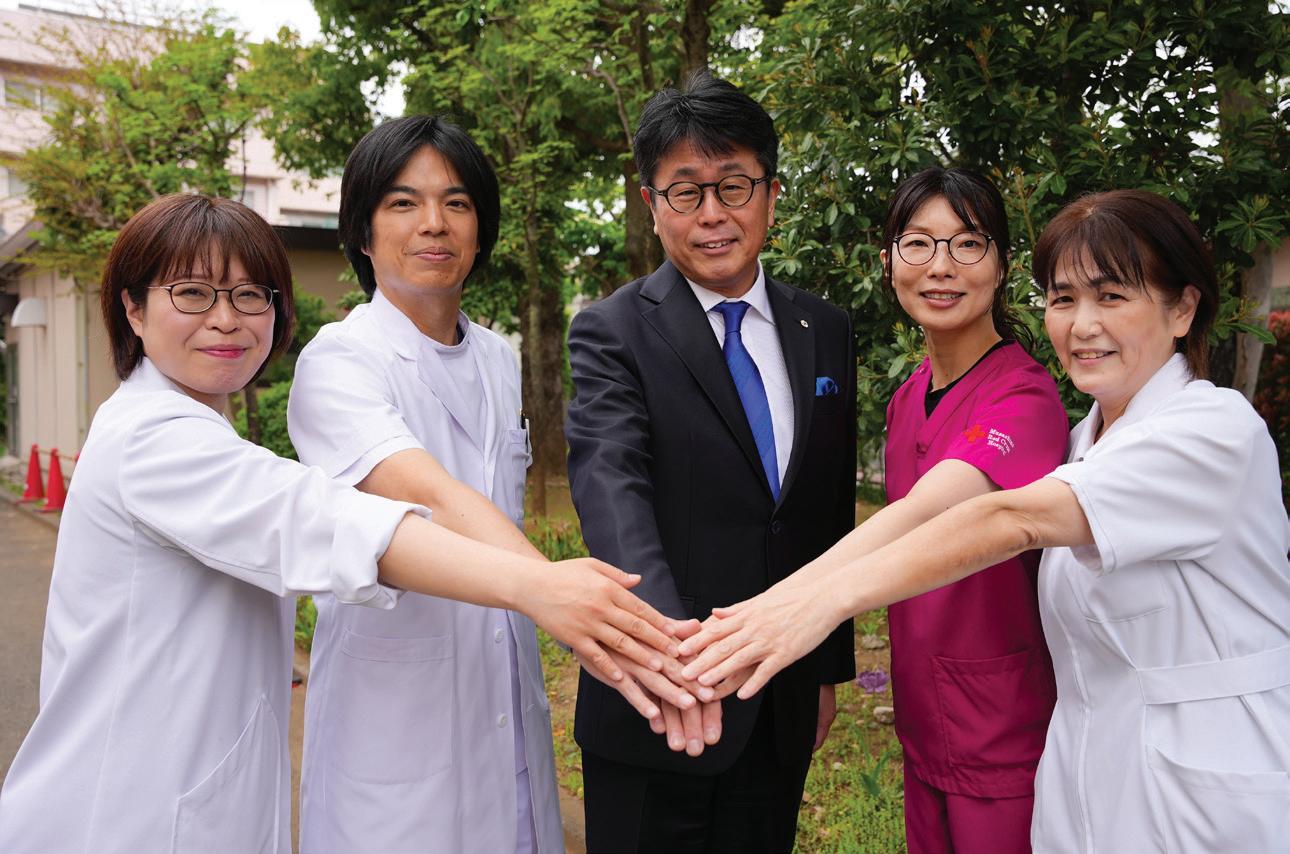
4.23 hour reduction in ED length of stay for patients who do not require observation. Congratulations to the top winning care teams and to all integrated clinical care teams receiving recognition in 2025! For more information on UNIVANTS, the 2025 winners, and/or to apply starting August 1st, please visit www.UnivantsHCE.com.
1. Strain C, Ravalico T. Electric trends of laboratory medicine: Five years of growth, visibility, and opportunity. J Appl Lab Med. 2025;10(2):440-454. doi:10.1093/jalm/jfae152.
2. The UNIVANTS of Healthcare Excellence award program. The UNIVANTS program. Accessed June 25, 2025. www.UnivantsHCE.com.
3. Hepatitis. World Health Organization (WHO). Accessed June 25, 2025. https:// www.who.int/health-topics/hepatitis/ elimination-of-hepatitis-by-2030#tab=tab_1.
4. Tanaka J, Kurisu A, Ohara M, et al. Burden of chronic hepatitis B and C infections in 2015 and future trends in Japan: A simulation study. Lancet Reg Health West Pac. 2022;22:100428. doi:10.1016/j. lanwpc.2022.100428.

Colleen Strain, PhD is a Scientific Manager at Abbott, Core Diagnostics focused on innovation and the value of laboratory medicine to stakeholders outside of the clinical laboratory. colleen serves as the Scientific Lead for the uniVantS of Healthcare Excellence award program, which recognizes, celebrates and amplifies best practices in healthcare that are enabled by laboratory medicine.
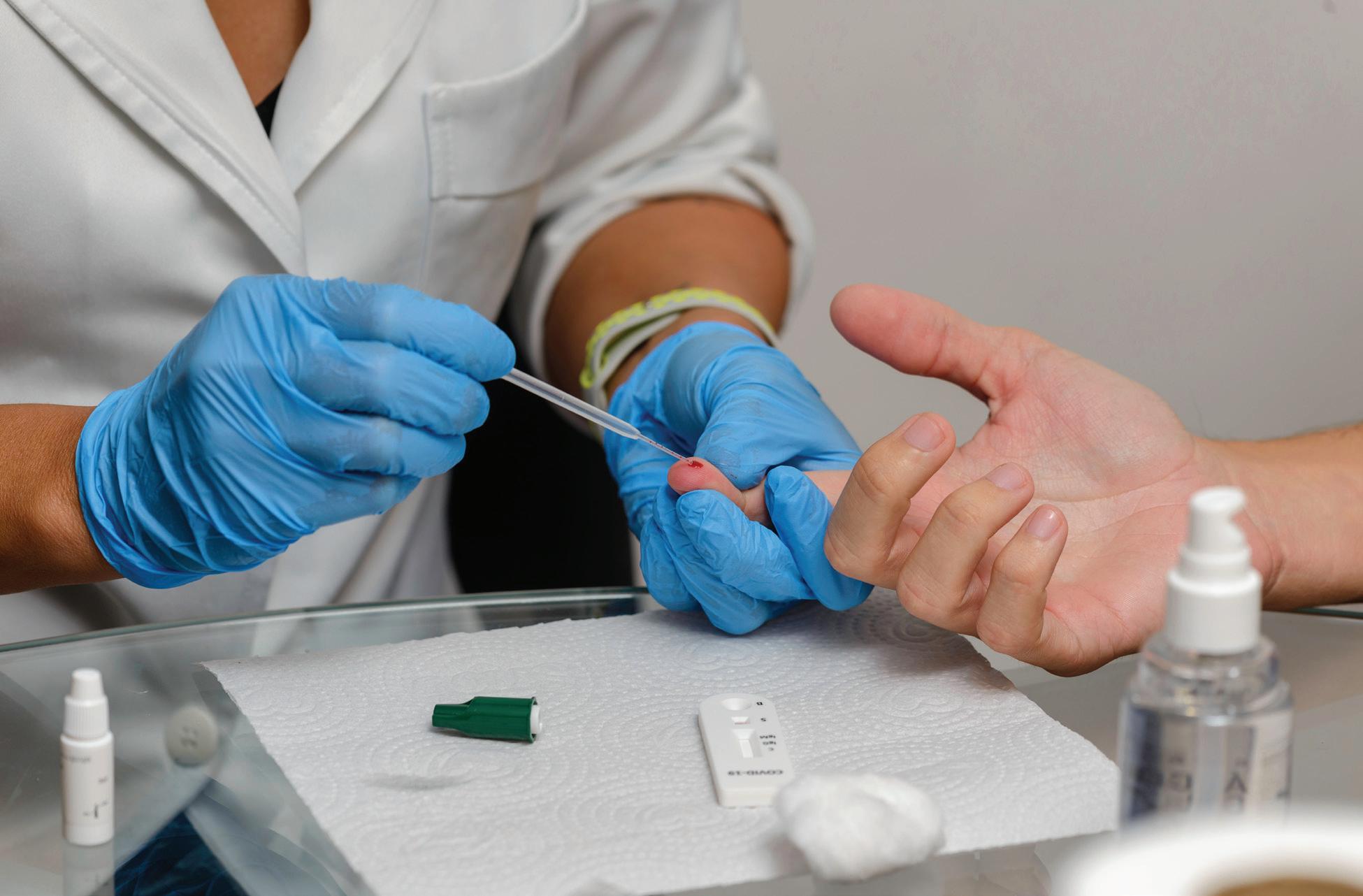
By Maria Paulina Posada-Vergara, MD, MSc and Robert F. Moran, PhD, FCCM, FIUPAC
The first ‘laboratory test’ was point-of-care! Physicians in ancient Egypt, Greece, and even in neolithic cultures of Amazonia, looked at a patient’s presentation and reasoned that if something inside was wrong, ‘whatever came out’ might help evaluate the cause and suggest a cure. Urine, stool, sweat, blood, etc. — look, smell, taste — they began to figure things out at the bedside.
Even in the early scientific age (18th & 19th centuries) this was true. It was only in the mid-20th century that clinical medicine became so diverse and analytically high tech that only a central or reference laboratory could manage the increasing demand for clinical testing and analysis. Today ‘s bio-engineered analytical systems, as well as data processing innovation, has allowed us to get back to the original near-patient testing for basic chemistry and cell counts as well as presumptive microbiology. Much of the complexity of routine central lab testing has been simplified such that non-specialists can use measurement systems to measure what took a specialist to perform in the recent past.
POCT versus CCT: While critical care testing (CCT) in the emergency room or intensive care unit is frequently thought of as POCT, we believe that CCT is a singular category in itself — one that typically combines in situ POCT, and central and specialty lab operations geared to most urgent priority testing.1,2,6,8,9,11,16
There certainly are commonalities between de facto POCT and CCT — primarily provision of correct testing results in
a brief time interval. In order for POCT to be a requirement for an institution instead of simply an extension of CCT, one must evaluate the 1) size and scope of the institution (e.g., hospital and clinics, hospital alone, clinics alone); 2) scenarios unique to certain patient populations served; and 3) location relative to other healthcare institutions (urban, rural, remote).
POCT In large healthcare facilities/institutions (LHCF): LHCFs, especially those with campus-like configurations and both hospitalized patients and clinics, are candidates for POC testing. Laboratory leadership, as well as clinical chemists, laboratory technologists, and other analytical and technical specialists must have a seat on institutional planning committees, in addition to medical staff and institutional administration/ownership. A needs assessment must include long-range planning as well as a working philosophy of rapid adaptation to innovative technology and clinical discoveries. Such flexibility can only happen within a broad-based institutional group that has a continuing and real, rather than just pro forma presence in the institution.
For POCT, planners must consider various options for testing efficiencies particularly for care areas with the following characteristics: 1) physically remote from the central laboratory, 2) have patients with either ambulatory or retention difficulties (drug treatment clinics), 3) treat immunocompromised patients (transplant department or HIV-AIDS clinic), 4) OB/GYN clinics. Clinical providers may be concerned not only about the timeliness of test results but also about
exposing their patients to individuals with other illnesses. There may also be concerns about the physical or emotional stress of traversing the institution to get lab tests performed and returning for treatment. The central laboratory may be concerned with random interjections of these patients and specimens as ‘stats’ that interrupt their efficient workflow. In each of these situations, POCT in the clinic is beneficial for clinical care, patient convenience, patient retention, and timely follow-up with the patient.
Under the general aegis of a cross-functional institutional laboratory committee as required under various regulatory bodies, laboratorians must collaborate with clinical staff in the assessment, implementation, and ongoing operation of such laboratories, particularly including the choice, use, and suitability of any information management systems. Specific needs assessment, analytical instrument selection, as well as ongoing central laboratory oversight are essential for success to ensure both the best immediate clinical care but also records/ financials management. (A small reminder here for IT and billing departments — Medicare. Let us make sure the bill and list of services performed is understandable to the patient, too!)
Instrumentation: Specific solutions are dependent on institutional size and physical layout as well as geographical area covered by the institution and so, a description of options goes well beyond the scope of this report. One question to answer might be, do we need a POCT lab or just a phlebotomist and pneumatic tube connection to the central lab? One example of out-of-the-box thinking regarding the types of options to consider for a POCT chemistry system from our own experience with blood gas analyzers (BGAs): If your POCT is not in a pulmonary clinic, why would you even think of a BGA? They are for testing arterial blood and used in the emergency room.
However, did you know that some BGA configurations include sodium/potassium/bicarbonate/ TCO2/glucose/urea (BUN)/creatinine. And the specimen can be venous or arterial blood (one small vacuum tube) without centrifugation. Results are available before the patient rolls their sleeve back after the venipuncture! Little bench space used, and an MD, RN, PA, or a medical assistant (regulations permitting, of course) can
do the test. Easy specimen processing, lightning-fast results, no pneumatic tube system, and no central lab (except for oversight). That’s truly point of care!
Information technology: IT is the link between and among these care areas. While the primary focus must be to provide the clinically necessary information to the caregiver accurately and in a timely fashion, setting up the systems to deliver this requires dedicated laboratory/caregiver/IT interaction as described in earlier Medical Laboratory Observer articles.13,15 For optimization of clinical utility, one must go beyond simply allowing the electronic health record (EHR) of one location to be able to ‘shake-hands.’ Electronics should enable correct rearrangement of information to ease the care being made in each clinical area without corrupting the original source of information at any of the connected locations.
Specific solutions are dependent on institutional size and physical layout as well as geographical area covered by the institution.
Specimen characteristics: Test results, especially from systems that are multiplexed, need special attention regarding identification of specimen characteristics (i.e., anatomic source, type of specimen, and measurement basis). We would recommend more consistent and widespread use of IFCC (International Federation of Clinical Chemistry and Laboratory Medicine) specimen characteristic symbols (SCS), specifically the inclusion of these characteristics as part of the measurand name as IFCC recommends.12,15 This information is more important than ever due to the capabilities of multiplexed systems, which report values on single specimens with concentrations based on different volumes within the whole specimen.
One example of this is the blood gas systems that report on the same specimen, total hemoglobin (Hb concentration in volume of whole blood), carboxyhemoglobin (as fraction of total Hb), bicarbonate (concentration in plasma volume), and sodium (as concentration in plasma or in the plasma-water fraction [this last example being a 7% bias]). While the
laboratorian may know the difference, the caregiver and especially the IT professional may not know or be aware of the significance of the difference. With the advent of more sophisticated testing methods as well as potential for various tissues being subjected to laboratory testing, provisions for more specific
A small reminder here for IT and billing departments — Medicare. Let us make sure the bill and list of services performed is understandable to the patient, too!
characterization of each measurand reported result must be made.
Extra institutional testing: Patients receive care in varied settings such as primary care provider/physician offices, urgent care facilities, or a combination of the two independent entities that refer patients to LHCFs. Subsequently, if testing is needed, laboratories will collect new specimens and do additional and frequently duplicative testing, adding costs and patient inconvenience. Both laboratory management and administration of LHCFs must address facilitation of the incorporation of prior testing information originating in physician offices and urgent care facilities, concomitantly assuring both compliance with legal and regulatory guidelines and simultaneously working to ensure that these results are readily available and part of the electronic health record (EHR) at the LHCF, thus reducing repeat testing and enabling more timely and efficient clinical evaluation (See Figure 1).
Every effort should be made on a local or regional level to encourage this. This should include, as necessary, the changing of institutional policy/procedures and inter-institutional co-operation as well as petitioning authorities on changes/exceptions to any confounding regulations.
Intra- and inter-institutional testing: Within a single institution, laboratory testing for clinical diagnosis and treatment (both POCT and central laboratory) should, from a technical perspective, be overseen by the clinical laboratory and its leadership, but with overall guidance and needs evaluation from a cross-functional institutional committee. Budgetary issues are separate, but
technically and from a legal operational perspective, the laboratory is where the expertise and responsibility reside. Meeting both the clinical treatment and patient needs for testing, even with an effective and efficient central laboratory, are not always feasible in a single location — and so we have POCT for the wound care clinic, transplant clinic, oncology, HIV/AIDS, and the OB/GYN clinic. Each clinic/care center’s patients can be seen, assessed, and treated as quickly and efficiently without patient inconvenience or disruption in the central lab’s in-patient routine test processing. There is no single best way to do this; for some situations, the clinic may just need a dedicated phlebotomist and a dipstick lab with a pneumatic tube for specimen transport. For other situations, more sophisticated testing may be performed by professional laboratorians, nurses, or medical assistants. Whatever the choice for your institution’s situation(s), all is linked by the patient health record so a clinic visit is compatible with the rest of the institution and available for reference in case of later, e.g., hospital care.
1. CLSI- GP26-A4, Quality Management System: A Model for Laboratory Services. Clinical and Laboratory Standards Institute. Wayne, PA.
2. Elser R, Hess D, Moran RF. Assessment of the agreement between duplicate whole blood measurements of blood gases and pH on independently calibrated analyzers. Methodology and Clinical Applications of Electrochemical and Fiber Optic Sensors 1990;11.
3. Moran, RF. Computer Standards, Healthcare Management Briefs. 1990.
4. Villanova PA. Standardization of Sodium and Potassium Ion-Selective Systems to the Flame Photometric [Reference Method: Approved Standard NCCLS Document C29-A2.; 2000.
5. Burnett R, Ehrmeyer SS, Moran RF, vanKessel A. Blood gas and pH analysis and related measurements; Approved Guideline. NCCLS C46-A. Published online 2001.
6. Moran RF. Point-of-care vs central Lab “discrepancies”: Getting the message across. J Appl Lab Med. 2017;1(5):595-597. doi:10.1373/jalm.2016.021485.
7. Moran RF, Liesching TN. The ABC’s of ABG’s: A Cyclopedic Dictionary of the Testing Terms Used in Critical Care.; 2018.
8. Nichols JH, Alter D, Chen Y, et al. AACC guidance document on management of point-of-care testing. J Appl Lab Med 2020;5(4):762-787. doi:10.1093/jalm/jfaa059.
9. Nichols JH. Utilizing point-of-care testing to optimize patient care. EJIFCC 2021;32(2):140-144.
10. Moran RF. POC testing and reporting of sodium, and other small molecules need modified IFCC source/type designations to improve operational efficacy and for clinically accurate, unambiguous reporting from LIMS and HIS. EJIFCC. 2023;34(4):271-275.
11. Jenkins J. What can go wrong with point-ofcare testing? CLN. Published July 1, 2023. Accessed June 25, 2025. https://myadlm.org/ cln/articles/2023/julaug/what-can-go-wrongwith-point-of-care-testing.
12. Moran RF. Moran RF. POC testing and reporting of sodium, and other small molecules need modified IFCC source/type designations to improve operational efficacy and for clinically accurate, unambiguous reporting from LIMS and HIS. EJIFCC 2023;34(4):271-275.
13. Moran RF. Overcoming data management challenges: The biggest challenge of all is….us. Medical Laboratory Observer January 29, 2024. Accessed June 25, 2025. https://www.mlo-online.com/ information-technology/data-management/ article/53081209/overcoming-datamanagement-challenges-the-biggestchallenge-of-all-isus.
14. Moran RF. Point-of-care testing — Managing change when you are not in charge. Medical Laboratory Observer. July 22, 2024. Accessed June 25, 2025. https://www.mlo-online. com/continuing-education/article/55094063/ point-of-care-testing-managing-changewhen-you-are-not-in-charge.
15. Moran RF. Use of IFCC/IUPAC format for specimen and test method display in the electronic health record facilitates increased accuracy of information. J Appl Lab Med 2025;10(3):738-742. doi:10.1093/jalm/jfae112.
16. Moran RF, Posada-Vergara MP. Critical care testing: The laboratorian in the emergency room. Medical Laboratory Observer. April 21, 2025. Accessed June 25, 2025.

Maria Paulina Posada-Vergara , MD, M sc received her medical degree from the national University of c olombia and her M sc from the University of s ao Paulo, s P, Brazil. s he is an Infectious Diseases f ellow from Instituto de Infectologia e milio r ibas , s ao Paulo, Brazil. Her more than 25 years of clinical practice have included health provider training and service implementations in urban and remote settings. Dr. Posada-Vergara’s extensive expertise in delivering healthcare in low-income settings across a frica and Latin a merica has focused on HIV/a ID s , hepatitis, tuberculosis, st Is, and tropical diseases.

Robert F. Moran, PhD, fcc M, f IUPac is the Principal scientist at mviSciences, a consulting and educational services organization and President of accutest™ Proficiency testing services. Dr. Moran served multiple terms on the ncc L s (now c L sI) Board of Directors and was an active participant or chairholder in several of their blood gas and electrolyte standards-writing teams. a lso active in clinical chemistry internationally, he is an appointed f ellow of the International Union of Pure and a pplied chemistry (f IUPac). He is a retired professor of chemistry and physics from Wentworth Institute of technology but remains active in consulting work and writing.



















Unistik® 3 Safety Lancets provide solutions for nearly all of your capillary sampling needs. Designed with both you and your patients in mind, Unistik® 3 delivers comfort, reliability, and ease of use.
• Multiple Gauge Sizes & Depths to match virtually every need
• Comfort Zone Technology® helps minimize pain for patients1
• Permanently Retracts for added safety and reduced risk
Available on contract with major GPOs—plus aggressive contracting and incentives available.


Discover the Value of Unistik® Scan to Get a Free Value Analysis!

By Kara Nadeau
The 2025 Medical Laboratory Observer (MLO) State of the Industry (SOI) survey on Disease Management focused on Alzheimer’s/dementia and respiratory testing. With regards to the former, MLO queried medical laboratory professionals about clinical reasons for Alzheimer’s/dementia test ordering, specific biomarkers tested, methodologies used, and number of tests performed over the past year.
As for the latter, participating medical lab professionals responded to questions on respiratory testing volumes, viruses for which they have seen the most positive results, and types of tests their labs are using to diagnose respiratory viruses.
Given the uncertainties related to the global supply chain, MLO also asked medical lab professionals whether geopolitical factors were affecting their labs’ purchasing/inventory management strategies.
Among the survey respondents, nearly half (48%) hold laboratory director, manager, administrator, or supervisor positions and the majority (62%) are employed by health system or hospital labs. The number of employees who work in their labs spanned the spectrum, with 29% reporting 1-10 employees, 23% more than 100, and the others falling in ranges in between.
Alongside the quantitative results, we include commentary from medical lab professionals and vendors in the Alzheimer’s/dementia and respiratory testing spaces.
When asked how many tests their labs had performed for Alzheimer’s/dementia in the past 12 months, nearly half of lab professionals (48%) selected the low end of the volume spectrum (0-100 tests) while 9% reported performing high test volumes (500+ tests).
Additionally, 4% of survey respondents performed 101-250 tests and 2% 251-500 tests. More than one-third of lab professionals (36%) indicated they were unsure

how many Alzheimer’s/dementia tests their labs had performed in the past year.
Turning to Alzheimer’s/dementia testing methodologies, the most used among lab professionals surveyed was complete blood count (44%), followed closely by urinalysis (40%), blood glucose (40%), and analysis of thyroid and thyroid-stimulating hormone levels (36%). One-quarter of respondents use drug and alcohol testing (25%), 24% cerebrospinal fluid analysis, and 20% toxicology testing.
More than half of respondents (51%) reported using other testing methodologies. When asked specifically what they used, lab professionals cited heavy metals testing, comprehensive metabolic panel (CMP) blood tests, APO lipoprotein panel, and tests to rule out prion diseases and other conditions.
Several lab professionals commented on how they send Alzheimer’s/dementia tests to reference/referral labs versus performing them in-house, while one noted how they have plans to reinstate this testing in their lab.
As MLO reported in May 2025, nearly all Americans think early Alzheimer’s diagnosis is essential, according to a survey conducted by Alzheimer’s Association.1 The trend toward early Alzheimer’s/dementia detection and diagnosis was seen in MLO’s SOI survey as well, with 39% of lab professionals citing differential diagnosis as the primary clinical reason for ordering this testing and 37% citing early detection as the main reason.
Additionally, 15% of survey respondents reported monitoring progression and 9% research as the primary clinical reasons for clinicians ordering Alzheimer’s/dementia testing.
“It is expected that the combination of biomarker tests, early diagnosis, and therapy will positively impact AD patients and their families.”
Zivjena Vucetic, MD, PhD, Chief Medical Officer (CMO) Beckman Coulter Diagnostics, shared her thoughts on the importance of testing for early diagnosis:
“Alzheimer’s disease (AD) is a very complex disease where early diagnosis may change the trajectory of the disease by allowing for interventions to slow cognitive decline and improve quality of life. With the number of people over 60 worldwide expected to double by 2050, the development of blood-based AD tests is a global priority.”
Most lab professionals surveyed (63%) reported that their labs test no specific biomarkers for Alzheimer’s/dementia testing. The most tested biomarkers were phosphorylated tau (18%) and APOE genotyping (17%). This was followed by total tau (14%), Aβ42 (12%), and neurofilament light chain (8%). Furthermore, 14% of lab professionals indicated they test other biomarkers, but these were not specified in the survey comments.
Dr. Maria-Magdalena Patru, Scientific Partner for Neurology at Roche Diagnostics, commented on the availability of Alzheimer’s disease (AD) biomarker tests for early detection of amyloid pathology and amyloid-targeting therapies which slow down cognitive decline. She highlights the central role clinical laboratories can play in translating these advancements in clinical practice.
“Evidence indicates that the use of AD biomarkers in the clinical context improves diagnosis accuracy, especially in early stages, when therapies are most effective,” said Dr. Patru. “Currently, the CSF ratio assays are an option for determining patient eligibility for therapy. Once FDA cleared blood-based biomarker tests are integrated in clinical practice, they will complement, but not entirely replace, the need for the CSF ratio assays in confirming AD pathology.”
“By validating scalable AD biomarkers tests, laboratories can address the need for greater access to diagnostics, which in turn facilitates timely therapeutic interventions,” she added. “It is expected that the combination of biomarker tests, early diagnosis, and therapy will positively impact AD patients and their families.”

Phd

dr. Maria-Magdalena Patru
Dr. Vucetic highlighted the need for testing that is applicable across diverse populations, stating:
“To develop accurate, reliable tests, we examine different biomarker levels across different populations. AD’s complex nature, with variations in genetic makeup and progression, means new blood-based tests must consider heterogeneity in biomarker levels across ethnicities and races. Global partnerships with organizations like Davos Alzheimer’s Collaborative and Global Alzheimer’s Platform Foundation are essential for accessing diverse patient cohorts. These efforts aim to create equitable and effective diagnostic solutions, ensuring no Alzheimer’s patient is left behind.”
Nearly half of laboratory professionals surveyed (48%) have seen a moderate increase in respiratory testing over the past 12 months, while nearly one-third (27%) have
experienced a significant increase and nearly a quarter (24%) have seen no increase in this testing category.
When asked which respiratory viruses have yielded the most positive test results, influenza A/B topped the list with 82% of survey respondents, followed by COVID-19 at 63%. Over one-third of lab professionals reported having the most positive test results for respiratory syncytial virus (RSV), 25% strep A/B, 13% rhinovirus, and 5% pneumonia.
A small percentage of those surveyed (3%) indicated they did not know which respiratory virus tests had the most positive results in their labs, and other 5% selected “other” as their response, citing high volumes of positive testing results for tuberculosis and mycoplasma (local outbreak).
According to Leonard Scinto, MS, MPA, DLM(ASCP), Technical Consultant at Advancing Health Laboratories, based in South Florida, the past 12 months have been “uneventful for any significant respiratory trends” in the state’s respiratory virus activity for Influenza A/B and COVID-19. He stated:
“Influenza test positivity did not show any dramatic spikes compared to 2023-2024. The same trend was seen for COVID-19 over the past 12 months; no dramatic increases were seen.”
“RSV showed a different picture in Florida,” he added. “Florida’s RSV season is longer than the national average, starting in April and peaking in November. November 2024 showed significantly higher RSV test positivity rates than previous 2023-2024 season. This significant positive increase related to three factors: Increased RSV circulation in Florida’s elderly population, increased use of multiplex PCR panels now including RSV targets, and a change in the Florida DOH mandatory reporting of RSV testing which began in 2024.”
The director of a medical laboratory based in Maryland commented on the respiratory virus trends in her area, stating:
“We have seen an increase in enterovirus/rhinovirus testing with a significant
Figure 1: What is the primary clinical reason for ordering Alzheimer’s/dementia testing in your lab? Early detection Differential diagnosis
Monitoring progression




decrease in flu and COVID-19 testing. The use of molecular respiratory panels proved to be important for the clinical treatment of respiratory infections.”
Turning to test modalities to diagnose respiratory viruses, highest on the list was nucleic acid amplification test, with 65% of survey participants citing how they used this method in their labs. Nearly half of lab professionals reported using rapid immunoassays (49%). Lower on the list were cultures (13%), serological tests (13%), direct fluorescent antibody tests (8%), and electron microscopy (1%).
Edmund Janoszewski, Senior Product Manager, Diasorin, spoke to trends in respiratory test modalities, stating:


“The emergence of respiratory testing patterns over the past two to three years has prompted many laboratories to develop integrated testing algorithms that incorporate a variety of respiratory testing methods, including rapid antigen tests, point-of-care molecular testing, targeted molecular assays performed in the lab, and flexible syndromic assays. These testing algorithms, based on diagnostic stewardship, aim to accurately identify the causative pathogens, ensure timely results to guide patient treatment, and promote effective management of healthcare costs.”

“In simpler terms, laboratories are focused on choosing the right test for the right patient at the right time,” Janoszewski continued. “Additionally, as the customer demand for accurate, fast, and affordable
tests increases, diagnostic testing companies must carefully design their tests and overall testing portfolios to support the dynamic needs of expanding healthcare systems.”
Galit Gelman, Senior Commercial Marketing Manager, SEKISUI Diagnostics, commented on the benefits of
“As the customer demand for accurate, fast, and affordable tests increases, diagnostic testing companies must carefully design their tests and overall testing portfolios to support the dynamic needs of expanding healthcare systems.”
combination testing for multiple respiratory viruses, stating:
“Clinicians are choosing carefully how to test for common respiratory illnesses, like Flu A&B and COVID-19, as it can have an impact on the experience their patients have while seeking answers when visiting the clinic. Long-wait times, multiple swabs, and leaving without answers can be frustrating to patients. A benefit of a point-of-care COVID/Flu combo test is a reduction to the discomfort and waiting and can really make a difference for your practice. This is why we are seeing more clinicians opt-in to molecular and antigen combo testing when Flu and COVID-19 are co-circulating.”
MLO also queried medical lab professionals on whether geopolitical factors were affecting their labs’ purchasing/
2: What types of tests are your laboratory using to diagnose respiratory viruses?
Electron microscopy Culture
Direct uorescent antibody tests
Rapid immunoassays
Nucleic acid ampli cation tests

Serological tests Percentage (%)
inventory management strategies. Most (75%) said “no” and the remaining 25% said “yes.” Those responding in the affirmative were asked to elaborate on the impact.
Several survey participates commented on challenges accessing products manufactured in China, with one
Figure 3: Are geopolitical factors affecting your laboratory’s purchasing/inventory management strategy?


lab professional noting how a vendor asked their lab to switch to an alternative product manufactured elsewhere. Others cited funding restrictions impacting their purchasing/inventory management strategies, including lack of access to capital budgets, government cutbacks and uncertainty around grants limiting their budgeting and buying ability. One lab professional commented on how it is too soon to tell how geopolitical factors will impact the medical lab supply chain but added that their lab’s GPO cited these factors as one of their top three concerns.
Scinto spoke about the uncertainties ahead, stating:
“Currently, the impact has not been felt in supply chain disruption or significant cost increase in our general lab supplies, testing reagents and media. However, this can change in a matter of weeks to months as we get more clarity on the impact trade tariffs in the U.S. and other global countries will have on specific laboratory testing supplies.” He recommends lab leaders take an immediate proactive approach to plan for potential supply chain disruptions and testing supply cost increases in three areas:
• Identify the manufacturing country of origin . Engage laboratory supply vendors in an open, evidence-based discussion on the materials being purchased in regard to manufacturing country of origin, changes in vendor manufacturing sites and manufacturing delays due to changes in production line modifications.
• Review current vendor agreements and contracts. Review agreements for price adjustment terms. What are pricing increases tied to: USA Consumer Price Index (CPI), International Bond Rates or some obscure Global Metrix where the manufacturer is based. Are price increases annual, or can they be adjusted multiple times over 12 months? When does the agreement expire, in the next 3-5 months or 3-5 years? What will be the financial impact to current and future budget expenses and revenue margins? If you’re engaged in current contract negotiations,
consider tariff protection and nonfinancial penalty exit clauses in new agreement terms.
• Maximize group purchasing organization (GPO) participation. Is your organization participating in a GPO that maximizes laboratory supply cost savings? Have you aligned your laboratory supply purchases through the GPO, or do you have legacy local vendor contracts? GPO participation often insulates against price increases for the term of the agreement.
MLO asked the laboratory professionals who contributed commentary for this article how manufacturers of testing equipment and supplies could better meet their needs.
“I would like to see our diagnostic manufacturers establish FDA approval for residual patient samples use,” said Scinto. “Manufacturers should seek FDA clearance for residual sample use by validating residual sample stability and performance especially for multiplex PCR. This could greatly enhance patient care, allowing reflexive test orders by clinicians on the primary/ initial collection sample negating the need for patient recollection.
“This would advance both diagnostic and antibiotic stewardship,” he added. “It is estimated that over 51% of antibiotic use in poorly defined respiratory illnesses is inappropriate. Diagnostic testing through defined reflexive testing algorithms could become focused on local/regional viral prevalence. Leading to overall reduced healthcare costs and accelerated patient outcomes.”
When asked what was on her “wish list” in the realm of testing, the Maryland-based medical laboratory director stated: “We would like to see lower costs for the reagents and analyzers used in the outpatient settings.”
1. Brady E. Americans’ attitudes toward Alzheimer’s testing. Medical Laboratory Observer. May 9, 2025. Accessed June 27, 2025. https://www.mlo-online.com/disease/ news/55289310/americans-attitudestoward-alzheimers-testing.

Kara Nadeau has 20+ years of experience as a healthcare/ medical/technology writer, having served medical device and pharmaceutical manufacturers, healthcare facilities, software and service providers, non-profit organizations and industry associations.

By Jim Aguanno, PhD and Justin Jones, PhD
For patients with diabetes, matters of the heart often carry a double meaning. While diabetes is associated with blood sugar, it is heart failure (HF) that increasingly threatens these “sweethearts.” Up to 22% of individuals with type 2 diabetes develop HF, even in the absence of coronary artery disease or hypertension.1 When chronic kidney disease (CKD) is also present, a common comorbidity in this population, the risk rises significantly due to overlapping pathophysiology and cardiorenal interactions. 2 Cardiac biomarkers, such as N-terminal pro-Btype natriuretic peptide (NT-proBNP)
and high-sensitivity troponin (hs-cTn), have demonstrated strong prognostic value in identifying patients at risk for HF before clinical symptoms emerge. 2 The intersection of diabetes, HF, and CKD highlights the need for earlier identification and intervention in asymptomatic patients.
Cardiac biomarkers overview: Troponins and natriuretic peptides
Cardiac biomarkers offer valuable insight into the subclinical processes of myocardial injury and stress that frequently accompany diabetes and
CKD. Their clinical value now extends beyond acute diagnosis into longterm prognostication and chronic disease management.
Cardiac-specific troponins reflect myocardial injury. High-sensitivity troponin assays can detect even very low concentrations of circulating troponin, indicative of subclinical cardiac strain. These “minimally elevated” levels, often present in stable patients, are independently associated with increased risk for future cardiovascular events and HF. Notably, troponin levels tend to be
chronically elevated in CKD yet still retain prognostic significance. In the BiomarCaRE consortium, high-sensitivity cardiac troponin I (hs-cTnI) levels predicted both incident HF and cardiovascular mortality, with thresholds proposed to stratify risk across sexes.3
BNP and NT-proBNP are secreted in equimolar amounts by ventricular myocytes in response to increased wall tension and volume overload.4 Despite this shared origin, they differ markedly in pharmacokinetics and clinical utility. BNP, the biologically active form, has a short plasma half-life of approximately 20 minutes and is cleared primarily by enzymatic degradation (e.g., neprilysin) and receptor-mediated pathways. In contrast, NT-proBNP is biologically inactive, has a longer circulating halflife of approximately 60 to 120 minutes, and is eliminated almost exclusively via renal excretion.4 These differences contribute to higher NT-proBNP plasma concentrations and greater analytical stability, making it especially useful in outpatient or chronic disease monitoring. While both biomarkers rise with declining renal function, studies have shown that they maintain independent prognostic value in patients with CKD.5
Analytical notes
High-sensitivity assays have enhanced the precision of cardiac biomarker measurement, enabling their use beyond acute care settings and into outpatient and preventive care. However, not all assays are interchangeable. For example, NT-proBNP and BNP differ in metabolism and clearance, with NT-proBNP having a longer half-life (60 to 120 minutes) compared to BNP (~20 minutes). Similarly, troponin I and T assays are distinct and require manufacturer-specific reference values. Interpretation is further refined by applying sex-specific and, in some cases, prognostic cutoffs to better personalize risk assessment.6
Biomarker roles in prognosis
Initially used to rule in or rule out acute myocardial infarction or HF, these biomarkers are now becoming recognized for their role in chronic disease risk stratification. Serial measurements allow clinicians to track disease trajectory and response to therapy, especially in asymptomatic high-risk groups, such as patients with diabetes and CKD. Their
Heart failure stages and recommended actions in patients with diabetes and CKD HF stage clinical Description biomarker role recommended action a at risk (e.g., diabetes, ckD, hypertension) screen with nt-probnP and/or hs-ctn annually initiate cardioprotective therapy (e.g., sglti) if elevated
b structural heart disease without symptoms screen with nt-probnP and/or hs-ctn annually intensify therapy, refer to cardiology, monitor progression
c/D symptomatic HF biomarkers are often markedly elevated standard HF management, consider specialist care
Table 1. Heart failure staging adapted from aDa and acc guidelines. annual biomarker testing (nt-probnP, hs-ctn) is recommended for stage a/b in patients with diabetes to identify subclinical cardiac stress and guide therapy1,3,7,8 sglt2i = sodium-glucose co-transporter 2 inhibitors.
use in routine clinical decision-making is increasingly supported by professional society guidance.5
Prognostic value of biomarkers in diabetes and cardio-renal disease
High-sensitivity cardiac troponin assays provide powerful risk stratification in asymptomatic patients with diabetes. In community-based cohorts without known cardiovascular disease, each log-unit increase in hs-cTnI was associated with approximately a 1.4-fold
The 2024 ADA Standards of Care recommend measuring NP levels (BNP or NT-proBNP) annually in individuals with diabetes to identify those at increased risk of developing symptomatic HF.
higher risk of incident HF, independent of traditional risk factors.3 These associations support the use of sex-specific thresholds to refine risk prediction and identify individuals at high risk earlier in the disease course.
Similarly, natriuretic peptides (NPs) offer compelling prognostic value. In the U.S.-based Atherosclerosis Risk in Communities (ARIC) study, NT-proBNP levels were independently associated with increased risk of HF, cardiovascular events, and mortality in patients with type 2 diabetes, even at levels below conventional thresholds.7 Participants with NT-proBNP ≥125 pg/mL had an increased hazard for incident HF and cardiovascular death.
Using hs-cTn and NT-proBNP in combination further improves prognostic
accuracy. Models incorporating both biomarkers have demonstrated excellent predictive performance, with patients exhibiting elevations in both facing significantly greater risk.7 The American Diabetes Association (ADA) now endorses the annual measurement of NT-proBNP or hs-cTn in asymptomatic diabetic patients to identify “Stage A/B” HF and enable early intervention.1
The 2024 ADA Standards of Care recommend measuring NP levels (BNP or NTproBNP) annually in individuals with diabetes to identify those at increased risk of developing symptomatic HF.1,8 When elevated, these biomarkers warrant follow-up evaluation, such as echocardiography, to assess left ventricular hypertrophy, reduced ejection fraction, or diastolic dysfunction (See Table 1).
Supporting this strategy, both NPs and hs-cTn have demonstrated strong predictive value for identifying patients in Stages A or B who are likely to progress to symptomatic HF or cardiovascular death.1 Annual measurement of either biomarker enables clinicians to risk-stratify patients earlier and implement preventative therapies that may delay or avert progression.
Clinical case scenario: A 58-year-old man with type 2 diabetes, hypertension, and stage 3 CKD (eGFR 45) presents without HF (NYHA Class I). Labs show NT-proBNP at 150 pg/mL (normal <125) and hs-cTnI at 6 ng/L.
Interpretation: Elevated NT-proBNP suggests subclinical cardiac stress (Stage B HF), while detectable hs-cTnI reflects low-grade myocardial injury. Per ADA consensus, this asymptomatic patient is high-risk and should undergo further evaluation, such as echocardiography.1
Action: Initiate or optimize cardioprotective therapy—start a sodium-glucose co-transporter 2 (SGLT2) inhibitor, optimize blood pressure (BP) control (e.g., ACEi/ARB), and encourage lifestyle changes. Monitor biomarkers over time to track progression or response.
Key point: Annual NT-proBNP or hs-cTn testing in asymptomatic diabetes can reclassify risk and guide early intervention.1
Guideline-directed therapy and biomarker use: SGLT2 inhibitors and GLP-1 receptor agonists
SGLT2 inhibitors:
Large cardiovascular outcome trials— including EMPA-REG OUTCOME, CANVAS, DECLARE-TIMI 58, DAPAHF, and EMPEROR-Reduced—have consistently demonstrated that SGLT2 inhibitors significantly reduce the risk
By integrating prognostic biomarkers into routine clinical workflows, laboratory professionals and clinicians can transition from reactive to proactive care.
of HF hospitalization and cardiovascular (CV) death in patients including those with diabetes.9-13 Zinman and colleagues demonstrated consistent benefits across populations, with metaanalyses reporting a 25%–30% relative risk reduction in the composite of CV death or HF hospitalization with SGLT2 inhibitor therapy.9,10 These benefits apply to patients with and without reduced ejection fraction, as well as those with CKD. Notably, reductions in NT-proBNP and stabilization of troponin levels have been observed in clinical trials, supporting the use of biomarker-guided monitoring.13
GLP-1 receptor agonists:
GLP-1 receptor agonists, such as liraglutide, semaglutide, and dulaglutide, have shown efficacy in reducing major adverse cardiovascular events in patients with type 2 diabetes. Marso and colleagues demonstrated that these agents improve overall cardiovascular risk profiles in patients with established atherosclerotic cardiovascular disease (ASCVD). 14 Their role in HF prevention is less consistent, but they remain a guideline-supported option.
Elevated NT-proBNP or troponin levels may prompt clinicians to intensify therapy and prioritize SGLT2 inhibitors where indicated.
Implementation:
In clinical practice, high-risk patients with diabetes, particularly those in HF Stage A/B or with CKD, should be considered for evaluation for SGLT2 inhibitor therapy. The ADA consensus recommends prioritizing SGLT2 inhibitors in these patients when biomarkers indicate subclinical cardiac stress or injury.1,8
Cardiac biomarkers, such as hs-cTn and NPs, are no longer limited to acute care settings; they are now essential tools for managing chronic diseases. In patients with diabetes and CKD, these markers can unmask silent cardiovascular stress well before symptoms appear. Current guidelines recommend annual screening to enable timely intervention and personalized care.
By integrating prognostic biomarkers into routine clinical workflows, laboratory professionals and clinicians can transition from reactive to proactive care. This approach enables earlier risk reclassification, optimized therapy decisions, and the potential to reduce the long-term burden of HF in high-risk populations.
1. Pop-Busui R, Januzzi JL, Bruemmer D, et. al. Heart failure: An underappreciated complication of diabetes. A consensus report of the American Diabetes Association. Diabetes Care. 2022;45(7):1670–1690. doi:10.2337/ dci22-0014.
2. Bansal N, Zelnick L, Go A, et al. Cardiac biomarkers and risk of incident heart failure in chronic kidney disease: The CRIC (Chronic Renal Insufficiency Cohort) study. J Am Heart Assoc. 2019;8(21):e012336. doi:10.1161/ JAHA.119.012336.
3. Yan I, Börschel CS, Neumann JT, et al. High-sensitivity cardiac troponin I levels and prediction of heart failure: Results from the BiomarCaRE Consortium. JACC Heart Fail. 2020;8(5):401-411. doi:10.1016/j. jchf.2019.12.008.
4. Weber M, Mitrovic V, Hamm C. B-type natriuretic peptide and N-terminal pro-B-type natriuretic peptide - Diagnostic role in stable coronary artery disease. Exp Clin Cardiol 2006;11(2):99-101.
5. McCullough PA, Sandberg KR. B-type natriuretic peptide and renal disease. Heart Fail Rev. 2003;8(4):355-8. doi:10.1023/a:1026195332025.
6. Apple FS, Wu AHB, Sandoval Y, et al. Sex-specific 99th percentile upper reference limits for high sensitivity cardiac troponin assays derived using a universal sample bank. Clin Chem. 2020;66(3):434-444. doi:10.1093/clinchem/hvz029.
7. Gori M, Gupta DK, Claggett B, et al. Natriuretic peptide and high-sensitivity troponin for cardiovascular risk prediction in diabetes: the Atherosclerosis Risk in Communities (ARIC) study. Diabetes Care. 2016;39(5):677–685.
8. American Diabetes Association Professional Practice Committee. 10. Cardiovascular Disease and Risk Management: Standards of Care in Diabetes-2024. Diabetes Care 2024;47(Suppl 1):S179-S218. doi:10.2337/ dc24-S010.
9. Zinman B, Wanner C, Lachin JM, et al. Empagliflozin, cardiovascular outcomes, and mortality in type 2 diabetes. N Engl J Med. 2015;373(22):2117–2128. doi:10.1056/ NEJMoa1504720.
10. Wiviott SD, Raz I, Bonaca MP, et al. Dapagliflozin and cardiovascular outcomes in type 2 diabetes. N Engl J Med. 2019;380(4):347–357. doi:10.1056/ NEJMoa1812389.
11. Neal B, Perkovic V, Mahaffey KW, et al. Canagliflozin and cardiovascular and renal events in type 2 diabetes. N Engl J Med. 2017;377(7):644-657. doi:10.1056/ NEJMoa1611925.
12. Inzucchi SE, Docherty KF, Køber L, et al; DAPA-HF Investigators and Committees. Dapagliflozin and the incidence of type 2 diabetes in patients with heart failure and reduced ejection fraction: An exploratory analysis from DAPA-HF. Diabetes Care 2021;44(2):586–594. doi:10.2337/dc20-1675.
13. Verma S, Mazer CD, Yan AT, et al. Effect of empagliflozin on left ventricular mass in patients with type 2 diabetes mellitus and coronary artery disease: The EMPA-HEART CardioLink-6 randomized clinical trial. Circulation. 2019;140(21):1693–1702. doi:10.1161/ CIRCULATIONAHA.119.042375.
14. Marso SP, Daniels GH, Brown-Frandsen K, et al. Liraglutide and cardiovascular outcomes in type 2 diabetes. N Engl J Med. 2016;375(4):311–322. doi:10.1056/ NEJMoa1603827.

Jim Aguanno, PhD received a bachelor of science in chemistry and a PhD in biochemistry from Memphis s tate university. Following his PhD, he did fellowship in l aboratory Medicine at Washington university school of Medicine and barnes Hospital in s t. l ouis, Missouri. Dr. aguanno was Director of the c ore l aboratory at baylor university Medical center in Dallas, texas for 24 years. Dr. aguanno joined Siemens Healthcare Diagnostics in January of 2004 and is currently Medical science Partner in the Medical and scientific a ffairs group.

Justin Jones, PhD has more than a decade of experience in diagnostics and translational science, including leading assay development projects at Siemens Healthineers in his current position as a Field Medical Partner, he specializes in cardiac biomarkers and clinical education. Justin holds a PhD in biochemistry and is dedicated to connecting laboratory insights with patient care.
Are you looking for hands-on materials to support your Medical Laboratory Science curriculum?
As a leader in clinical proficiency testing, API is developing new ways to provide colleges and universities with educational resources to enhance student learning.
Let us know what proficiency testing samples and curriculum support would be most useful for your classroom:













By Dan Scungio, MLS(ASCP), SLS, CQA (ASQ)
Every day, laboratory professionals work in environments where the smallest error can have outsized consequences. Whether handling infectious agents, hazardous chemicals, or complex instrumentation, the stakes are high, and the margin for error is slim. That means that the laboratory workplace should be considered a high-reliability organization (HRO). To ensure the laboratory embraces the spirit of a HRO, safety must become not just a goal but a way of life.
What is high reliability?
Why does it matter?
High reliability organizations are those that “operate under very trying conditions all the time and yet manage to
have fewer than their fair share of accidents.” The concept was born out of research in fields like aviation, nuclear power, and the military — industries where failure is not an option. These organizations face complex, hazardous systems daily, but through rigorous processes and a relentless focus on safety, they achieve remarkable safety records. In the laboratory, the parallels are clear. The technologies and products handled are risky, the consequences of error can be severe, and the environment is often unforgiving. Laboratorians cannot afford to learn from catastrophe. Instead, they must proactively manage risk, anticipate failure, and create systems that are resilient to human error.
The five principles of highreliability organizations
To view the lab as a high-reliability organization, five core principles must be observed, grouped into the categories of anticipation and containment . The first principle of anticipation is Preoccupation with Failure. Every small error should be treated as a symptom of a larger issue. Near misses should never be ignored. Instead, report, investigate, and learn from them. Sensitivity to Operations is the second principle of anticipation. Labs need to stay attuned to what is happening on the front lines. Leaders should spend less time in the office. They need to listen to staff, observe workflows, and be present in the lab. The last anticipation principle
of a high-reliability organization is the Reluctance to Simplify Interpretations. The culture of the laboratory should encourage diversity of thought and experience. Avoid oversimplifying problems when they arise, dig deeper to understand the true causes of laboratory incidents.
The first principle of containment is a Commitment to Resilience. It is vital for the laboratory to develop the ability to detect, contain, and recover from errors. When something goes wrong, bounce back quickly and learn from the event. This can be particularly helpful when implementing new technologies or processes and when working in collaboration with other departments. The second containment principle is known as a Deference to Expertise. Labs should push decision-making to those with the most relevant knowledge, regardless of their position in the hierarchy. For example, if a department build or remodel is underway, be sure to use an architect with lab-specific experience and include those who work on the front lines when designing the workspace.
Human behavior: The heart of safety
Risk in any environment is a function of both probability and consequence. While it may not be possible to reduce the consequences of a potential incident (for example, the outcome of a hepatitis exposure), the safety program can work tirelessly to reduce the probability of that incident occurring. By doing so, the lab can be recast as a low-risk department. A place where, despite the dangers, accidents are exceedingly rare.
Unfortunately, even in low-risk environments, human beings are fallible. Even the best-trained, most conscientious lab professionals make mistakes. However, high reliability is not about eliminating human error. It is about designing systems that anticipate, catch, and mitigate those errors before they lead to harm.
Dr. James Reason developed a Generic Error Modeling System (GEMS) that describes three performance modes in which errors occur. While working in the Skill-Based mode, routine tasks are performed on “auto-pilot.” Unfortunately, the more familiar one becomes with a task, the less attention is paid to it. Errors here are slips or lapses, often due to distraction or complacency.
Exposure incident-needs investigation
Water leak behind chemistry analyzer
Hematology analyzer down
Collecting lab coat sizes for transition
Waiting for part for walk-in refrigerator
In the Rule-Based performance mode, tasks are guided by established rules or procedures. The worker has adequate experience to make decisions about the work performed. Errors here arise from misinterpretation or applying the wrong decision.
The Knowledge-Based mode is in use when new or unfamiliar situations arise and where problem-solving is required. The worker does not have any past experience to go by when making decisions. Typically, errors will stem from making incorrect assumptions or from missing vital information. The arrival of the Covid pandemic, for example, brought labs several situations in which decisions had to be made with no prior experience.
While a high-reliability organization might have systems in place to reduce risks, humans are still able to make mistakes. In the lab, this means that even experienced staff are vulnerable to error, especially during routine activities.
When an incident occurs, the natural reaction is to blame the individual. But in high reliability labs, it is always important to look at the system first. What in the lab’s processes, procedures, or environment allowed the error to happen? Could it have been prevented by better design, clearer communication, or more robust checks?
If someone in the department trips over a loose cord, leadership should not simply ask why they were not paying attention. A system focus would drive questions about why the cord was there in the first place. Is there an existing system for identifying and fixing trip hazards? Are regular safety rounds conducted? This focus can better lead to systemic fixes, which prevent
All electrical cords tied up
Accumulation area posters in place
Normal blood inventory restored
future incidents and create a stronger culture of safety.
Safety in the laboratory must be visible and ever present. This means regular education and training, establishing safety champions in every department, and making safety a standing agenda item in every meeting. When staff see that safety is a priority for leadership, it becomes a priority for them.
Recognize staff who ask questions, suggest fixes, or take initiative to address safety issues. Celebrate stand-out safety performance. This not only reinforces positive behaviors
Conduct regular safety audits and encourage everyone to use their “safety eyes” as they move through the laboratory. Notice issues, follow up quickly, and close the loop on corrective actions.
but also encourages a culture where everyone feels responsible for safety.
Leaders must be present in the lab — not just seen but seen doing and asking about safety. Rounding to influence bridges the gap between administrative discussions and front-line realities. It shows staff that leadership cares and is actively looking for ways to improve safety.
Conduct regular safety audits and encourage everyone to use their
“safety eyes” as they move through the laboratory. Notice issues, follow up quickly, and close the loop on corrective actions. The faster hazards are addressed, the more trust will be built within the lab team.
Communication is the lifeblood of high reliability. Daily huddles—whether in person or virtual—keep safety top-of-mind and provide a forum for discussing ongoing issues, new hazards, and progress on corrective actions. High-reliability boards (see Figure 1), posted in the lab, make safety visible and invite staff to contribute concerns and solutions. When staff see that their input leads to action, engagement soars. Safety checklists are also a hallmark of high reliability. Sadly, not all
checklists are created equal. Effective safety checklists are concise, focus on critical steps, and use language familiar to staff. They should be tested and refined to ensure they actually improve safety, not just add paperwork. The true value of checklists is cultural—they enhance teamwork, improve communication, and shift responsibility for safety from individuals to the entire department.
When books are written about highreliability organizations, laboratories are often not mentioned. Given these organizations’ characteristics, however, it is clear that labs belong in that arena. A true high-reliability laboratory is a place where safety awareness is high and ever present. Incidents are rare, and when they occur, they are thoroughly investigated for systemic causes. Staff feel empowered to speak up about safety concerns. Leaders are visible, engaged, and committed to continuous improvement. Communication is open, frequent, and focused on learning, not blame. If these things exist in your
laboratory, the results will be a safer culture, fewer incidents with injuries or exposures, and a laboratory that truly lives up to its mission of protecting patients and staff alike.
As Mark V. Rosenker, former Chairman of the National Transportation Safety Board, once said, “Safety is not a lucky system. It is a system of science, analysis, and facts.” High-reliability safety in the laboratory does not happen by accident. It requires commitment, vigilance, and a willingness to learn and adapt. By embracing the principles and tools of high reliability, we can create laboratories where safety never sleeps—and where every team member goes home safe, every day.

Dan Scungio, MLS( a SCP), SLS, CQ a ( a SQ) has more than 25 years of experience as a certified medical tech. He was a lab manager for 10 years before becoming the laboratory safety officer for Sentara Healthcare, a system of 12 hospitals and more than 20 labs and draw sites in Virginia and north Caroline. a s “Dan the Lab Safety Man,” he provides consulting, education, and training in the U.S. and Canada.






















Abbott’s Alinity systems are flexible and scalable with an increased throughput and capacity, allowing you to easily add modules as volume grows without having to replace your systems.
Optimize BSI treatment in hours – not days.

LIAISON PLEX® bloodstream infection assays provide the flexibility to only test for clinically relevant targets based on Gram stain of a positive blood culture. Learn more about the panels designed to support your diagnostic and antimicrobial stewardship programs.
Diasorin
and CS-Series™
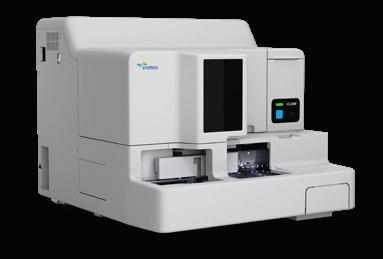
Sysmex’s innovative portfolio of hemostasis analyzers, reagents and controls are designed with quality, reliability and efficiency in mind. We provide advanced hemostasis technology across multiple platforms to match the needs of laboratories of all sizes.
Sysmex America Inc.
Unistik® 3 Side Activated Safety Lancets are designed to reduce pain for patients during sampling while providing confidence and control during capillary blood sampling. Unistik 3 permanently retracts, helping protect against accidental needlestick injuries, and features etched lot numbers for traceability.
Owen Mumford


Effortlessly upload results from your LIS and eliminate the #1 cause of PT failure--clerical errors.
• No changes to our firewall or security
• No interface required or software to install
• No additional fees—API DataDirect is free Join the over 9 million results uploaded utilizing DataDirect!
American Proficiency Institute
FDA Cleared: Rapid CTX-M
NG-Test® CTX-M Multi is the rapid, FDA-cleared immunoassay detecting CTX-M enzymes (Groups 1, 2, 8, 9, 25). Get results in 15 minutes with minimal training or equipment. Identify key extended-spectrum cephalosporin resistance.


Hardy Diagnostics
Diazyme’s Kappa and Lambda Free Light Chain Assays provide accurate, timely insights for the diagnosis and monitoring of Multiple Myeloma. Enhance your lab’s performance with trusted, high-quality results. Available on most major clinical chemistry analyzers.
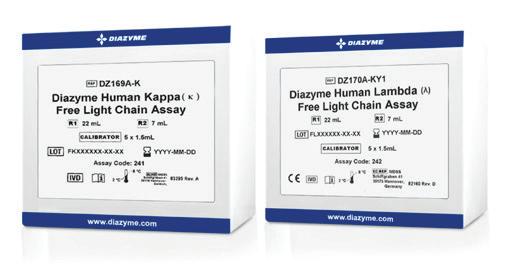
Laboratories
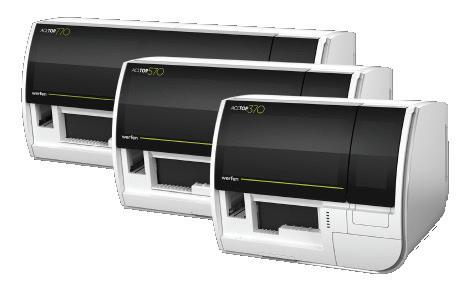
ACL TOP® Family 70 Series Hemostasis Testing Systems optimize workflow with a powerful combination of quality and efficiency—for the entire laboratory network. Offering centralized data management, automation and connectivity, and automated pre-analytical sample checks.
Werfen — Hemostasis

t he ids is Y s a utomated s ystem (is -310400) is a benchtop analyzer that uses chemiluminescent technology for endocrine immunoassays. i t offers random access for batch, continuous, and stat loading, processes up to 120 tests per hour, and delivers results in as little as 25 minutes.
EUROIMMUN (Part of Revvity)
t he e asy ra , a usa -made benchtop clinical chemistry analyzer, is wellestablished in many laboratories located in multi-site health systems, oncology clinics, and physician offices. i t has a menu of 35 general chemistries and 14 urine drug screens. training, installation, validation assistance, and warranty included with purchase. 0% financing through 11/2025.
Carolina Liquid Chemistries
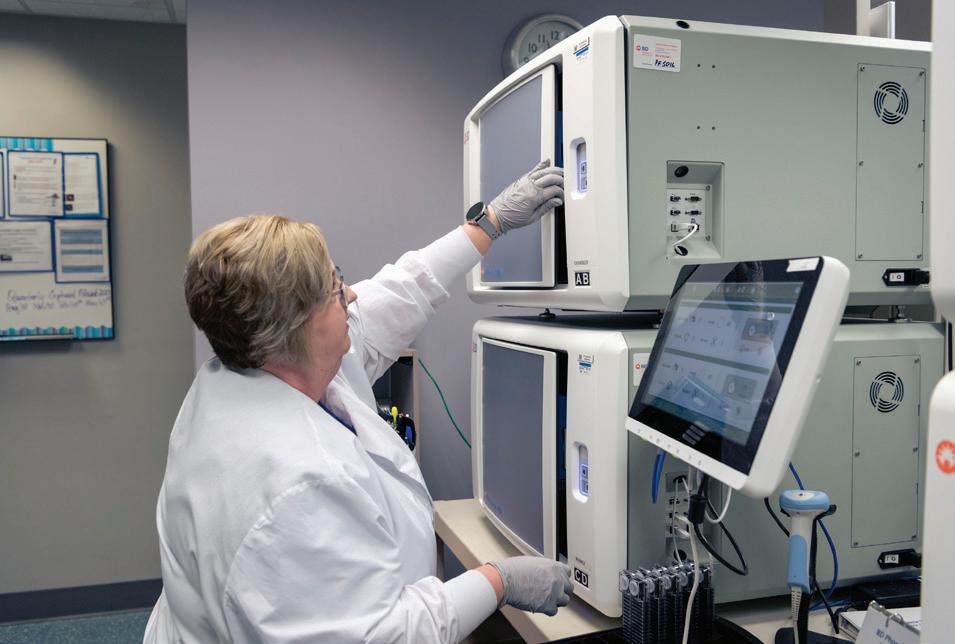
t he Bd Phoenix a utomated Microbiology s ystem is intended for the rapid identification (id) and antimicrobial susceptibility testing ( ast ) of clinically significant bacteria. t he Bd Phoenix s ystem provides rapid results for most aerobic and facultative anaerobic gram-positive bacteria as well as most aerobic and facultative anaerobic gram-negative bacteria of human origin.
BD
t he Mytemp 65 digital incubator (21088) from health c are Logistics can reach as low as 15º below ambient temperature and as high as 60º c use it to meet us P <797> guidelines that require two temperatures to determine bacterial and fungal results. interior features include adjustable shelves and an internal outlet.
Health Care Logistics



t he MicroFlow i Workstation is a ductless carbonfiltered workstation designed to collect small amounts of non-hazardous fumes and odors. i t is completely self-contained and has an integral recessed work surface to contain spills. c lear hood surround with safety viewing sash for the user.
HEMCO
t he hemo screen c B c a nalyzer delivers labgrade, F da -cleared 5-part differential results at the point of care. t his compact, easy-tointegrate device supports direct capillary sampling and requires minimal training, offering reliable hematology analysis with fast turnaround in clinical settings.
PixCell Medical


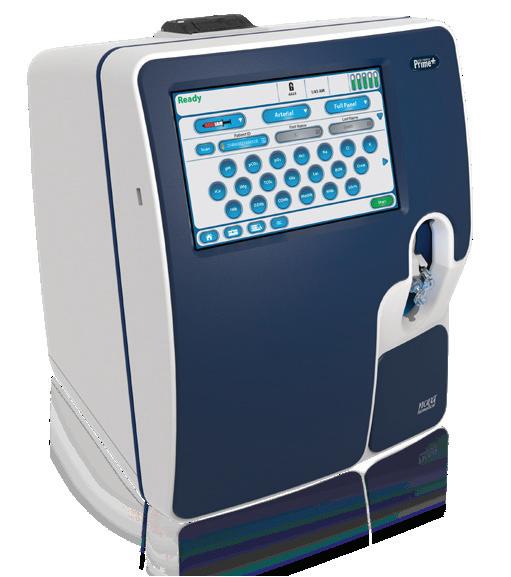
s tat Profile Prime Plus offers significant clinical value in a blood gas/critical care analyzer by providing the unique critical care tests. Blood oxygenation, tissue perfusion status, acid/base balance, electrolyte balance, fluid balance, glycemic control, and kidney function tests are available from two drops of blood in about 90 seconds at the point of care.
Nova Biomedical
Kap s afe recapper model 3101-1102-L s is a bench top 24” x 24” footprint for the automatic recapping of sample tubes, of various heights/diameters, at a throughput of 700 tubes/ hour. Kap s afe serves to eliminate exposure to repetitive stress injury during manual recapping. uses muti-tier caps to fit various tube diameters. o ther models available.
LGP Lab Automation
t he e vidence Multistat is a fully automated analyzer, providing simultaneous, semiquantitative detection of up to 29 drugs per sample in <30 minutes. designed to screen various matrices with a throughput of up to 176 tests/hour, offering rapid and accurate results. e asy-to-use software is touchscreen-controlled, and results are L iM s exportable.
Randox

Pentra c 400 c linical c hemistry a nalyzer:
• t hroughput of 420 tests per hour with ise
• e xtensive Moderate c omplexity test Menu with 70+ assays
• c apacity of 52 onboard assays
• no water system, drain, or special electrical required
• Benchtop with small footprint
• Pair with a BX Micros 60 hematology a nalyzer and Lite data Management
HORIBA
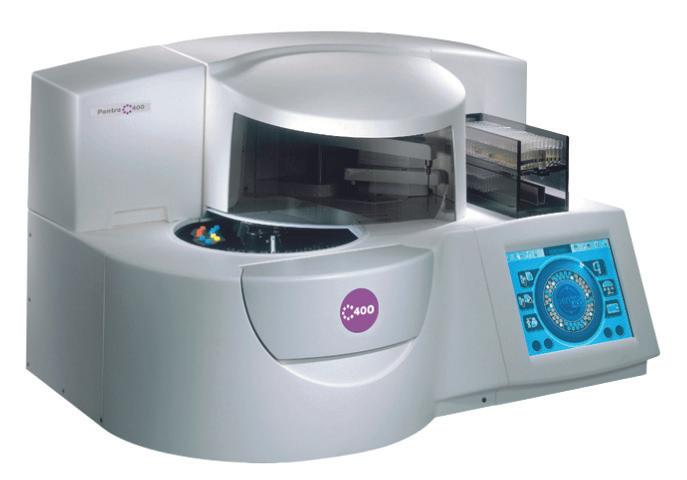
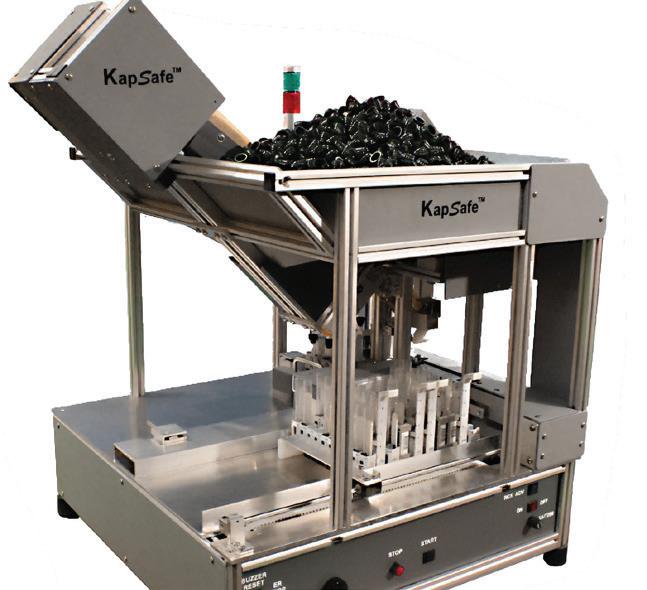

t he d x h 690 t is a quantitative, multi-parameter, automated benchtop hematology analyzer for in vitro diagnostic use in screening patient populations found in clinical laboratories.
Beckman Coulter
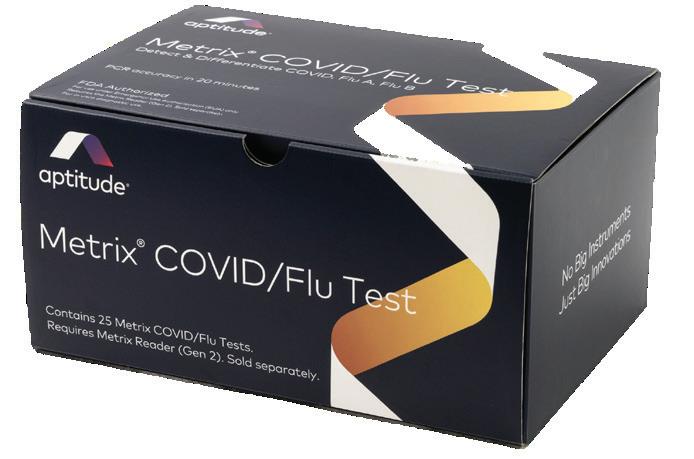
t he Metrix co V id /Flu test is a highly accurate molecular test with a small footprint and a seamless testing procedure that can accurately detect and differentiate between sars - c oV-2, Flu a , and Flu B at the point-of-care. use this simple, efficient, and affordable testing solution to deliver lab-quality results in 20 minutes.
Sekisui Diagnostics

Cecil James M. Buguis, DHSc, MSc, MBA, CTTS, MLS(ASCPi)cm is the Laboratory Director at Winkler County Hospital District in Kermit, Texas. With a multidisciplinary background in clinical diagnostics, health sciences, and healthcare administration, Dr. Buguis brings a strategic and community-centered approach to rural laboratory leadership. He holds a Doctor of Health Sciences, master’s degrees in Medical Laboratory Science and Business Administration, and is certified by the ASCP as an international medical laboratory scientist.
He was recently honored with the United States Public Health Service Award for Excellence in Public Health Pharmacy Award, a national recognition of his dedication to advancing healthcare in underserved communities. Dr. Buguis is currently pursuing a Doctor of Pharmacy degree, with a focused interest in expanding the clinical utility of diagnostic medicine and pharmacogenomics.
In addition to his hospital leadership, he serves as a clinical site coordinator and advisory board member for local college laboratory program. His work reflects a deep commitment to innovation, health equity, and patient-centered care across all facets of the healthcare continuum.
As a rural laboratory, what kind of staffing challenges does the Winkler County Hospital District Laboratory have and what ways do you try to overcome them?
As the Laboratory Director of a rural hospital, I’ve seen firsthand how staffing challenges can deeply impact operations. In our region, one of the main issues is a general lack of awareness about the Medical Laboratory Science profession. This often results in fewer students pursuing this path, and subsequently, a limited pipeline of trained personnel entering the workforce. To
By Christina Wichmann
address this, we participate in local career fairs and set up educational booths during community events like Kermit Week. We also distribute ASCP Lab Drawer Kits, hoping to spark curiosity in young minds about the world of diagnostic science.
Beyond outreach, I serve on the advisory committee for the Medical Laboratory Technology and Phlebotomy programs at Odessa College. Our hospital is also a clinical training site for the college, allowing students to gain hands-on experience in real healthcare settings.
Another hurdle is the scarcity of qualified professionals within our geographic area. Many graduates gravitate toward larger cities, so recruitment is an ongoing challenge. In response, I focus on retention—creating a positive, empowered work culture. I’ve eliminated on-call shifts while maintaining 24/7 operations, send staff to external training opportunities, and encourage continued education. Advocacy for their growth is advocacy for the lab’s success.
How do you handle equipment maintenance and technological upgrades in a rural hospital setting?
Equipment maintenance and technological upgrades in rural hospitals often require creativity, planning, and strong vendor relationships. We prioritize preventive maintenance contracts and align our upgrades with broader hospital initiatives or grant opportunities. Whenever possible, we choose analyzers that are scalable, easy to train on, and supported by remote service capabilities to minimize downtime. Careful review is essential before committing to any new technology. We always conduct a thorough cost-benefit analysis and focus on what matters. We focus on acquiring equipment that serves its intended purpose reliably without placing unnecessary financial strain on the facility. Building rapport with vendors has also been key; many have provided extended warranties and flexible payment terms in recognition of our rural constraints. Strategic planning and advocacy at the administrative level help ensure that laboratory priorities are considered
during budget discussions, allowing us to make smart, sustainable investments in technology.
It is also important to plan for the unexpected, as there will be times that a piece of equipment is down. That is why it is important to ensure to have a backup analyzer, or at the very least, point-of-care-testing (POCT) option to continue performing critically important tests such as cardiac markers and other routine chemistry tests.
What efforts has the hospital and laboratory taken to expand healthcare access for its rural patient population?
To expand healthcare access for our rural population, we’ve strengthened our collaboration with the state public health laboratory, enabling us to send out samples for advanced testing at no cost to our patients. This has opened doors to higher-complexity diagnostics while removing financial barriers. We are also pursuing approval to become a Texas Infertility Prevention Project (TIPP) partner, which will allow us to provide free STI testing, specifically for chlamydia and gonorrhea, to uninsured and underinsured individuals. Education, early detection, and access to treatment are at the heart of that initiative. Beyond the lab, the hospital participates in the Adult Safety Net (ASN) program, offering free immunizations to eligible adults. We also host free smoking cessation classes.
does being a lab director mean to you?
Being a laboratory director in a rural hospital goes beyond overseeing operations. It means being a champion of quality, a bridge between the diagnostic and the clinical team, and an advocate for access and equity in healthcare. It’s about serving not just patients, but the entire community by ensuring the lab remains a reliable piece of the puzzle towards a healthier life. I take great pride in guiding our team to adapt, grow, and innovate despite limited resources. At the end of the day, our work directly influences patient outcomes, and that’s a responsibility I carry with honor.

Hardy Diagnostics releases FDAcleared NG-TEST® CTX-M Multi in the United States. CTX-M Multi is an in vitro, rapid, and visual immunoassay for the qualitative detection of CTX-M enzymes (groups 1, 2, 8, 9, and 25) for the rapid detection of ESBL’s.
CTX-M-mediated ESBL-producing bacteria, primarily Escherichia coli, have been identified in various settings, including hospitals and long-term care facilities. While initially thought rate, CTX-M enzymes are now recognized as a significant cause of extended-spectrum cephalosporin resistance.
Using CTX-M Multi provides detection in just 15 minutes from isolated colonies.

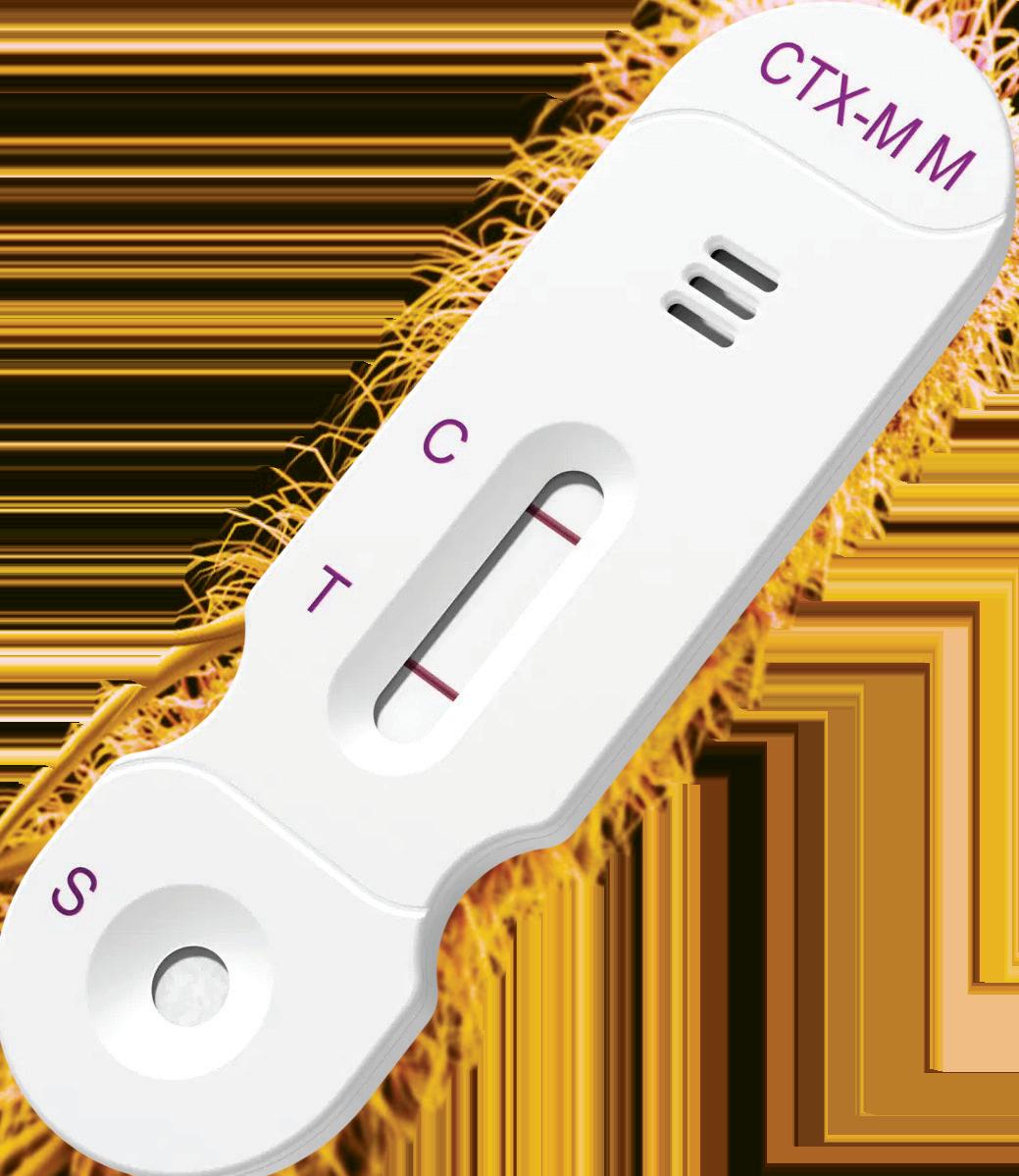



Clinical Relevance:
Proven clinical utility in the diagnosis & monitoring of multiple myeloma.
Efficiency:
Seamlessly integrates into major automated chemistry analyzers, delivering rapid results with minimal prep for optimized workflow.
Precision:

Delivers high sensitivity and specificity with accurate quantification of free kappa and lambda light chains for reliable results.





